What Is AI Keyword Research?
Keyword research refers to identifying what words or phrases your target audience uses in search engines. These words or phrases are also called keywords.
AI keyword research means using an AI tool to assist with finding new keyword ideas. And to generate personalized keyword suggestions and metrics.
Compared to traditional keyword research, AI keyword research is often quicker and easier.
For example, Semrush’s Keyword Strategy Builder uses AI to generate hundreds of keyword ideas within minutes. From a single seed keyword (“brewed coffee” in the example below).
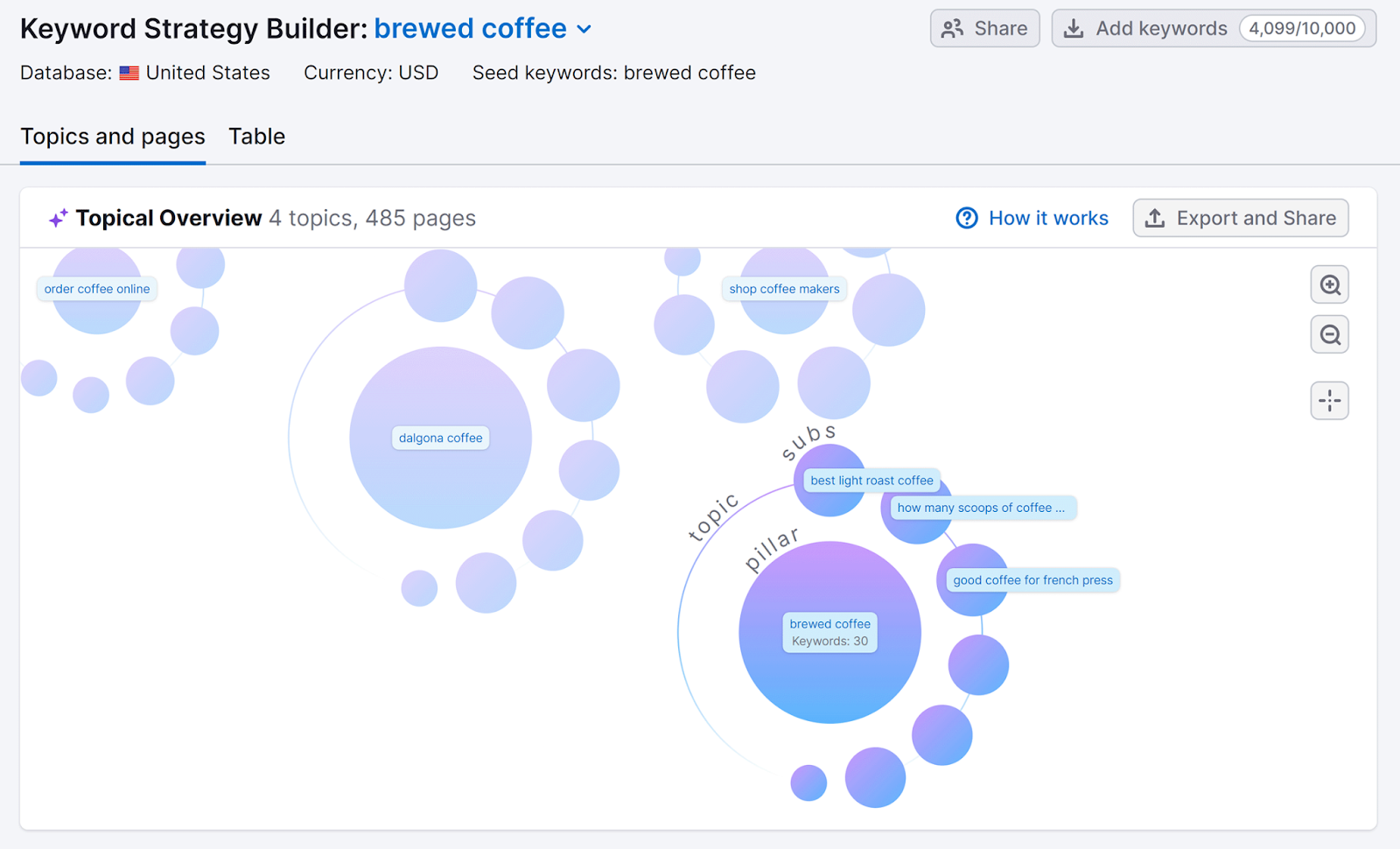
While ChatGPT is one of the more commonly used AI tools, traditional SEO platforms (such as Semrush) have also incorporated AI functionalities into their toolkits.
Dedicated SEO solutions produce reliable results. Because they offer keyword research tools backed by extensive data. Semrush, for example, has a database with over 25 billion keywords. And it’s constantly updated.
Benefits of AI Keyword Research
Understanding the benefits of AI keyword research will help you make the most out of these tools.
Easily Generate New Keyword Ideas
AI keyword research tools only need one prompt or seed keyword to instantly generate keywords. And they are usually easy to use.
With Semrush’s Keyword Strategy Builder, for example, you type a prompt in the space provided.
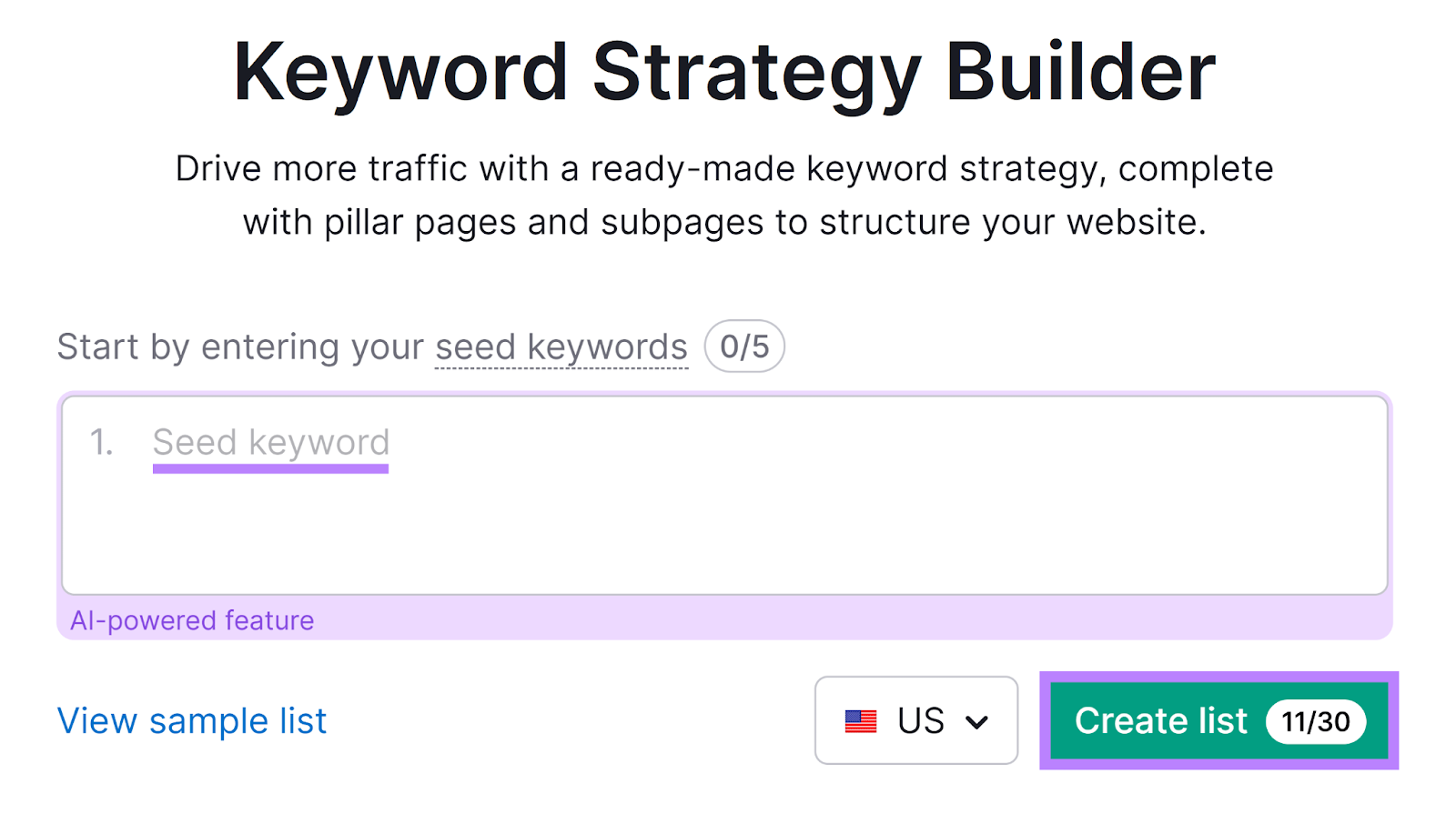
And it generates a full list of keywords (and some strategy).
This simplicity allows users with limited knowledge of traditional SEO tools to find keyword ideas. And save time on manual research.
Accelerate Keyword Analysis
AI tools can speed up keyword analysis. Instead of going through a keyword list manually, ask AI to identify patterns or group keywords according to shared characteristics.
For example, ChatGPT could analyze a keyword list and highlight long-tail keywords. Or remove keywords that don’t fit specific criteria.
Jumpstart Research About New Industries and Trending Topics
Learning about new industries and trends is important for keyword research. Because you need to know what’s current and trending to create effective content.
But manual industry and trend research can take a lot of time.
Generative AI summarizes large amounts of information. Making it easy to learn about new industries and trends quickly.
In the example below, ChatGPT summarizes the top trends in the skincare industry.

These results are a great jumping-off point for further keyword discovery. And they save marketers hours on conducting research from scratch.
5 Ways of Using AI for Keyword Research
AI-powered SEO tools have simplified and accelerated many complex tasks. Here are five simple ways to use AI for keyword research.
1. Instantly Generate Tons of Keyword Ideas
ChatGPT can come up with dozens of keyword ideas with a single prompt.
Then, you can use Semrush’s Keyword Magic Tool to get keyword data. And find out whether any of those ideas are worth targeting.
Here’s how.
You can use several types of prompts to generate keyword ideas with ChatGPT.
We recommend starting with a simple yet specific prompt. Which is ideal when you’re just starting your research and don’t know where to begin.
PROMPT: We are a business in (INDUSTRY). Our products target (AUDIENCE). Create a list of keywords that are most relevant to our target audience.
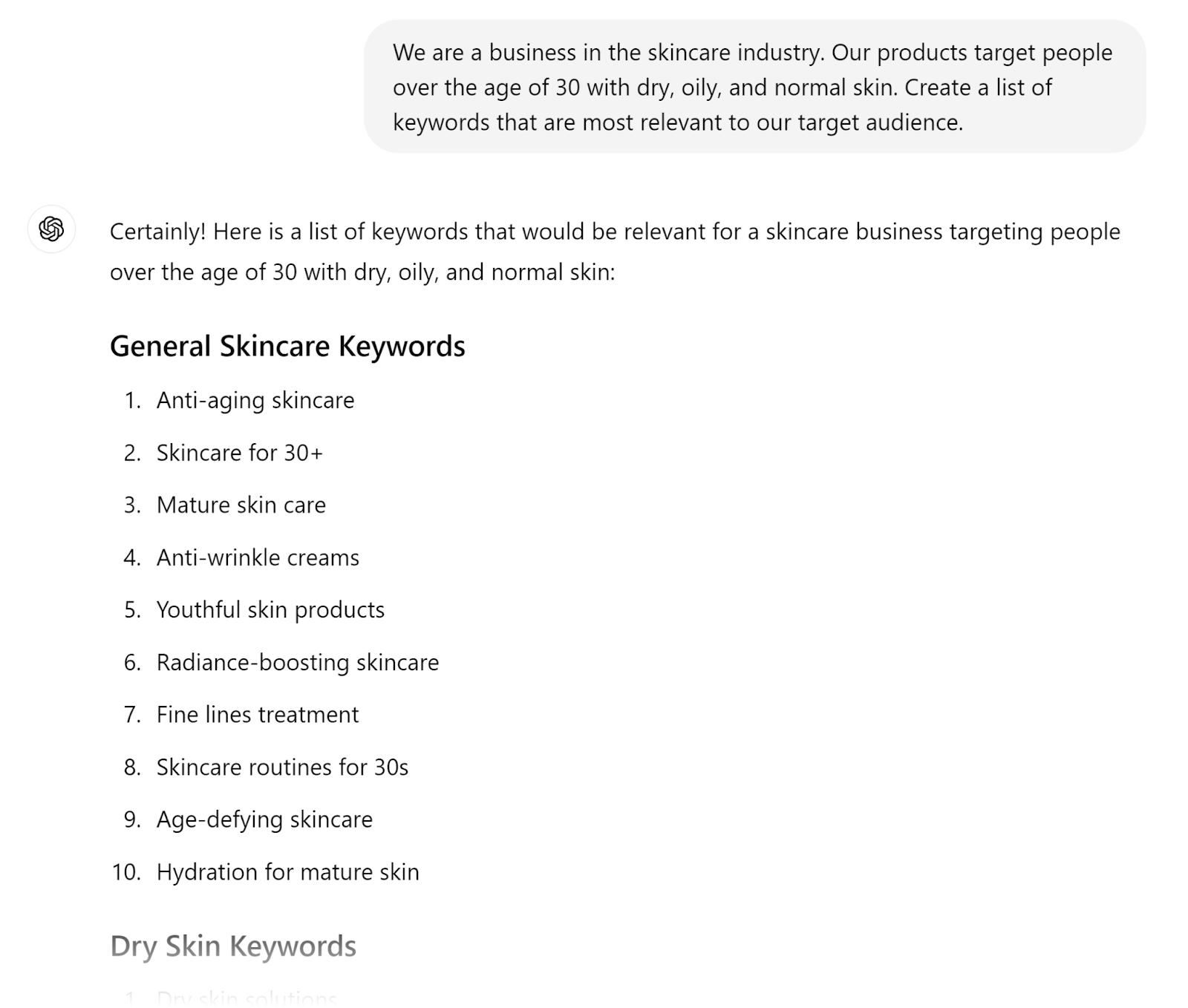
Or ask ChatGPT to act like Google autocomplete. All you need is a seed keyword. Then, pick a letter for the word that follows.
PROMPT: Create a list of keywords. The first word in the keyword is "(TOPIC)." The next word starts with the letter "(LETTER)."
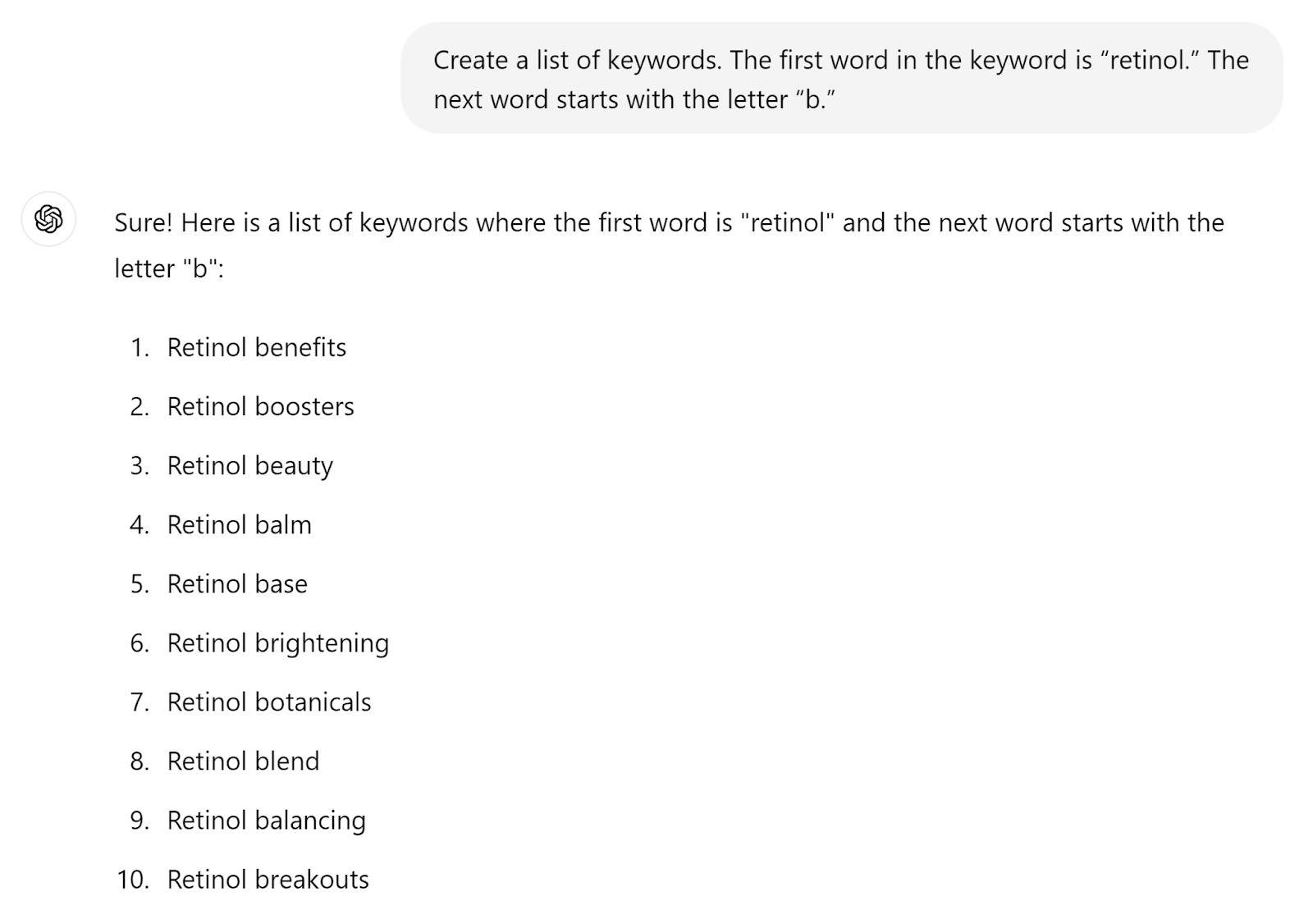
Although ChatGPT can help you generate ideas, you need more data to know whether a keyword is worth targeting. Data like monthly search volume, keyword difficulty, and search intent.
Semrush’s Keyword Magic Tool provides this data. And can generate numerous keyword ideas from one seed keyword.
Look through the generated ideas from ChatGPT. And enter one (or more) of them into the Keyword Magic Tool.
Enter your domain into the space provided to get AI-powered, personalized keyword data. Then, click “Search.”
For example, we entered “combination skin.” And entered the domain “sephora.com.”
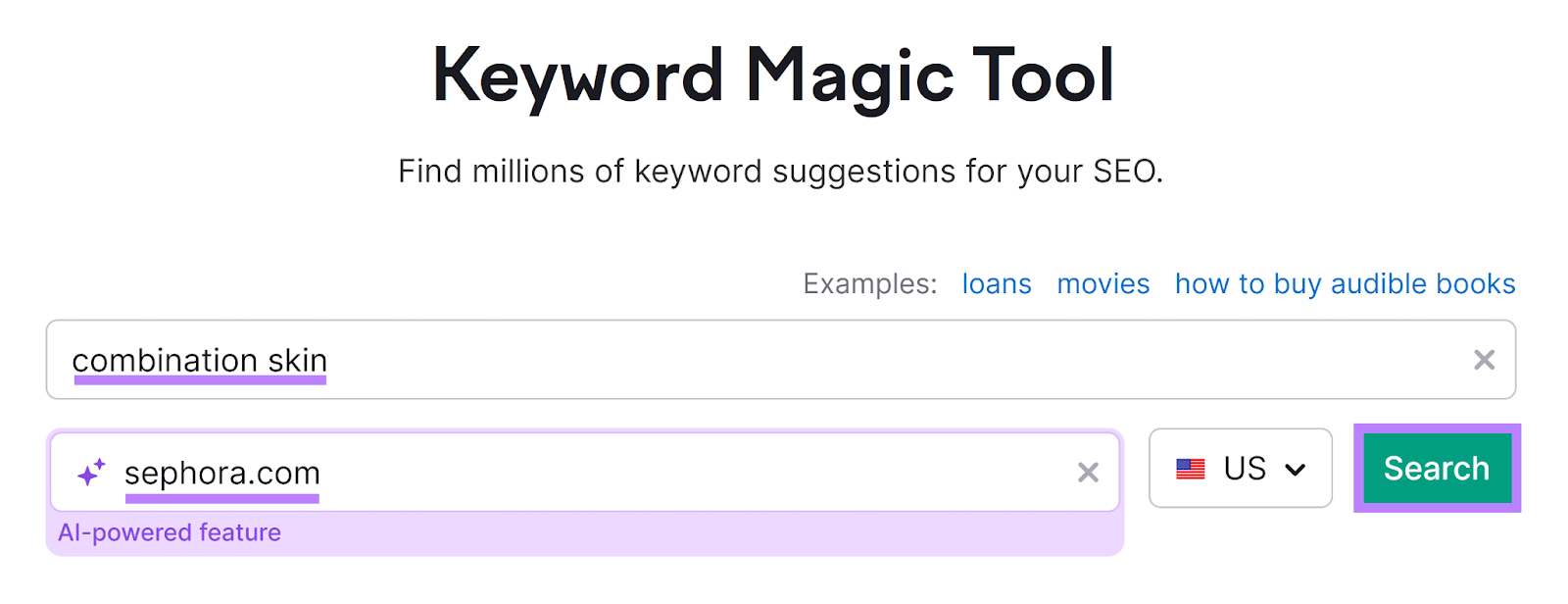
The tool returned a list of over 13,000 keyword ideas.
The results also include important keyword data like:
- Intent: Search intent is the reason people search for a specific keyword. For example, if the intent is informational (indicated by the letter “I”), then searchers just want to learn more. If the intent is commercial (indicated by the letter “C”), then searchers want to research a product or service.
- Your position on the SERP: Where you currently rank for a specific keyword. You can only see this metric if you added your domain in the first step.
- Volume: Search volume is the estimated number of times users search for a keyword per month. Opt for keywords with enough volume—a good rule of thumb is volume over 100. But depending on your content strategy goals, you might also choose keywords with a lower search volume.
- KD %: Stands for “keyword difficulty.” It’s a score from 0 to 100 that shows how hard it is to rank well for a specific keyword. If your domain has low or medium authority, consider keywords with a difficulty of 49%, at most. (This means they’re relatively easy to rank for.)
- PKD %: Stands for personal keyword difficulty. An AI-powered metric that tells your specific domain’s ranking potential for a specific keyword.
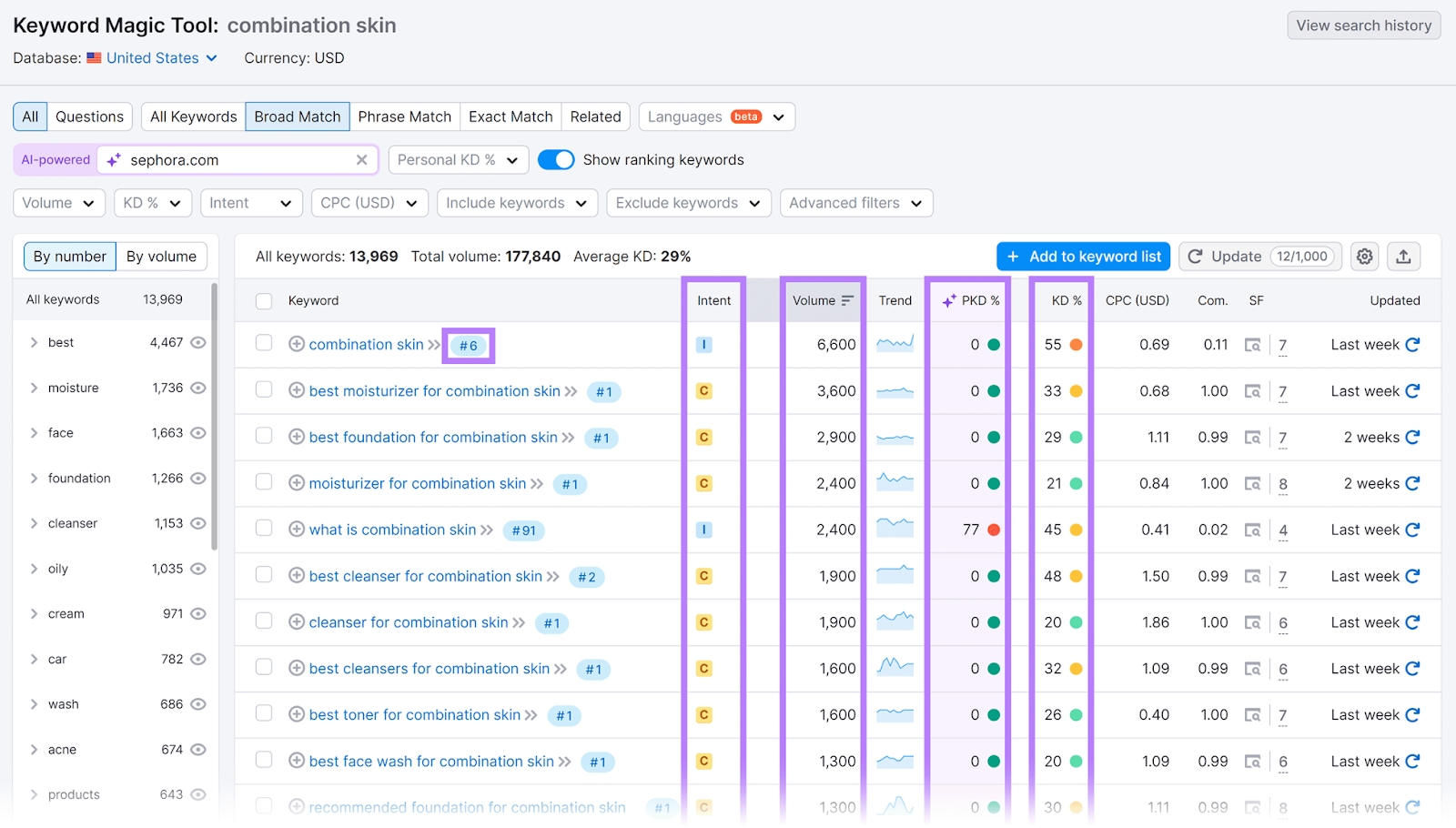
If you find a keyword that meets your criteria, take note of it as a potential target keyword. For easy organization, compile all your top picks in a keyword list by selecting the checkbox beside the keyword and clicking “+ Add to keyword list.”
In the example above, “combination skin,” “best moisturizer for combination skin,” and “cleanser for combination skin” are all great keyword ideas.
While “what is combination skin” might not be a great keyword to target.
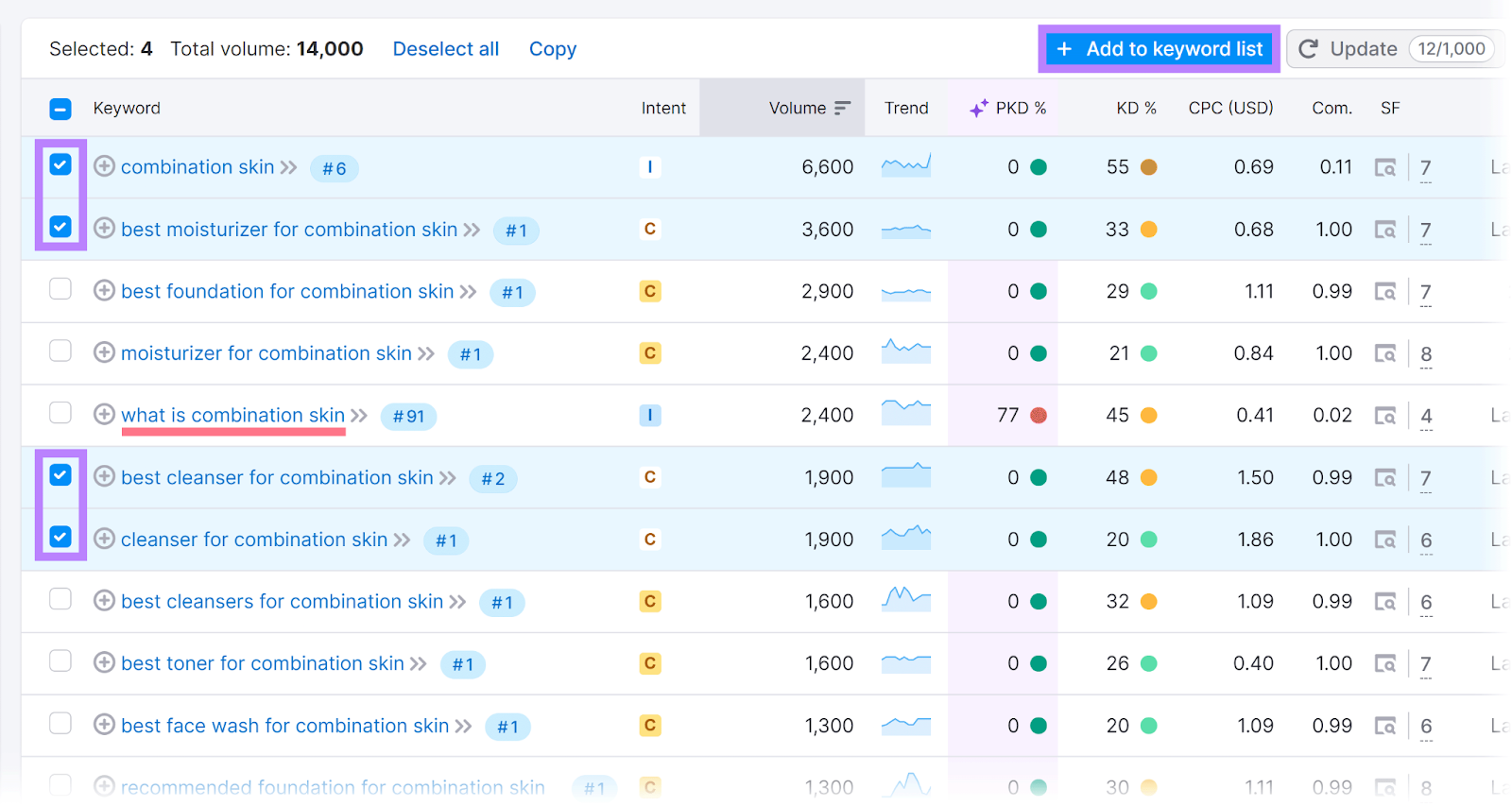
Use Keyword Magic Tool’s filters to get a list of more relevant keywords. For example, you can filter keywords by “Broad Match,” “Phrase Match,” “Exact Match,” or “Related.”
Or hide keywords based on keyword groups in the left-hand sidebar.
You can also filter keywords by “Volume,” “KD %,” “Intent,” and more.
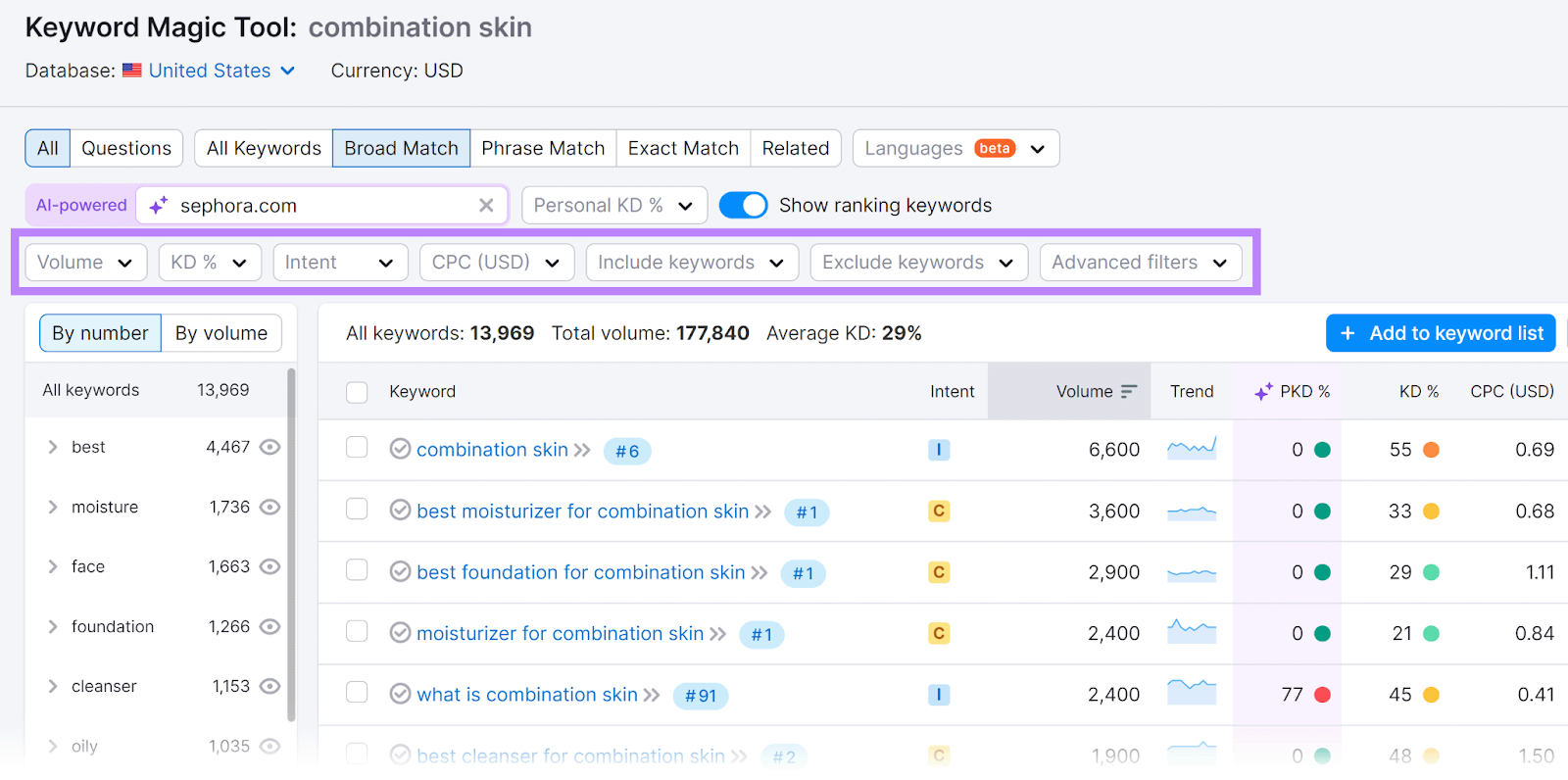
Now, you have a list of keywords you can target with your content. That you are likely to rank well for.
2. Find Low-Hanging Fruit Keywords Specific to Your Domain
Low-hanging fruit keywords are keywords your domain can easily rank well for. Either by tweaking existing content or creating new pages to target that keyword.
AI keyword research tools can look at your domain and find the following:
- Keywords your domain can rank well for based on your current rankings
- Keywords your domain doesn’t rank for but can do so easily
- Keywords your competitors rank for but you don’t
Instead of manually looking for those keywords, let AI automate the process.
For example, simply signing into Semrush and running an audit with Semrush’s Site Audit will give you access to Semrush Copilot.
It’s an AI-powered tool that gives you low-hanging fruit keyword suggestions and site optimization recommendations as soon as you sign in. Based on your domain’s performance.
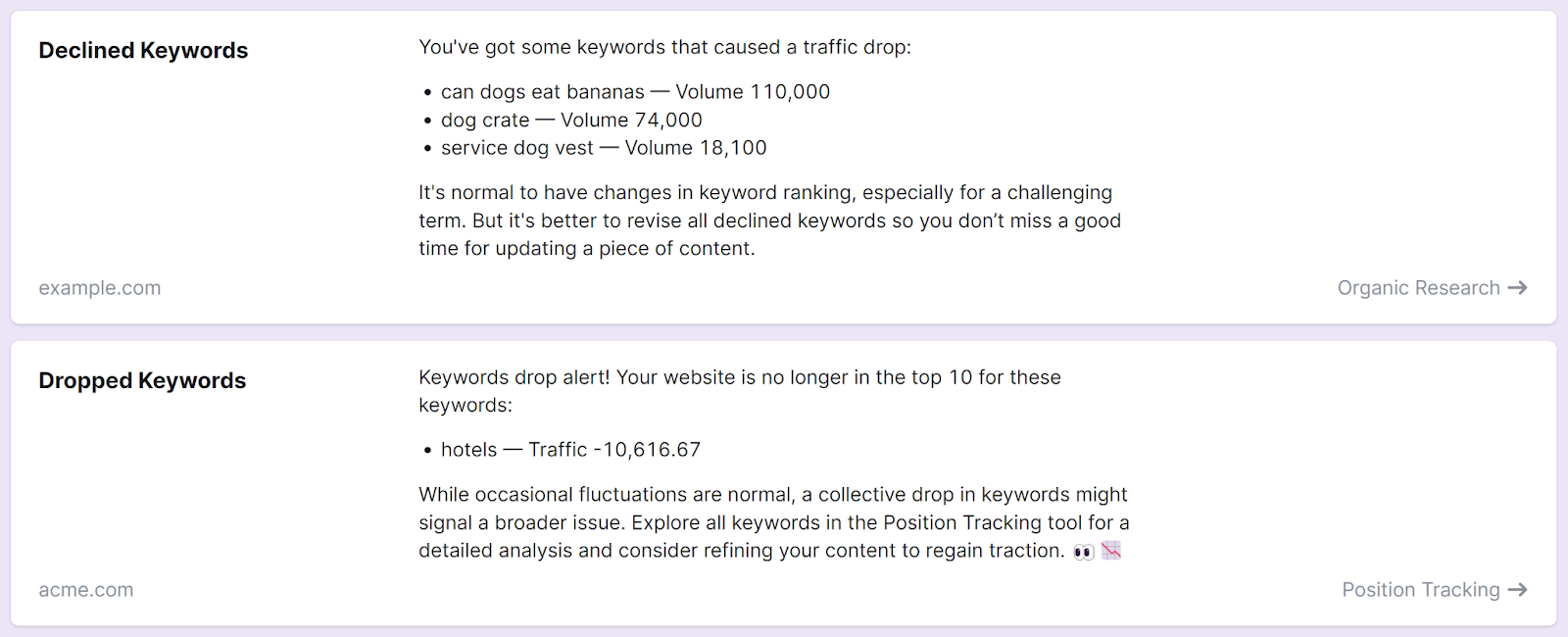
Another tool to take advantage of is Semrush’s Keyword Overview tool. That tells you your PKD % or specific ranking potential.
And makes it easy to find low-hanging fruit keywords.
First, enter your keyword. Then, paste your domain URL into the purple search bar below. Click “Search.”
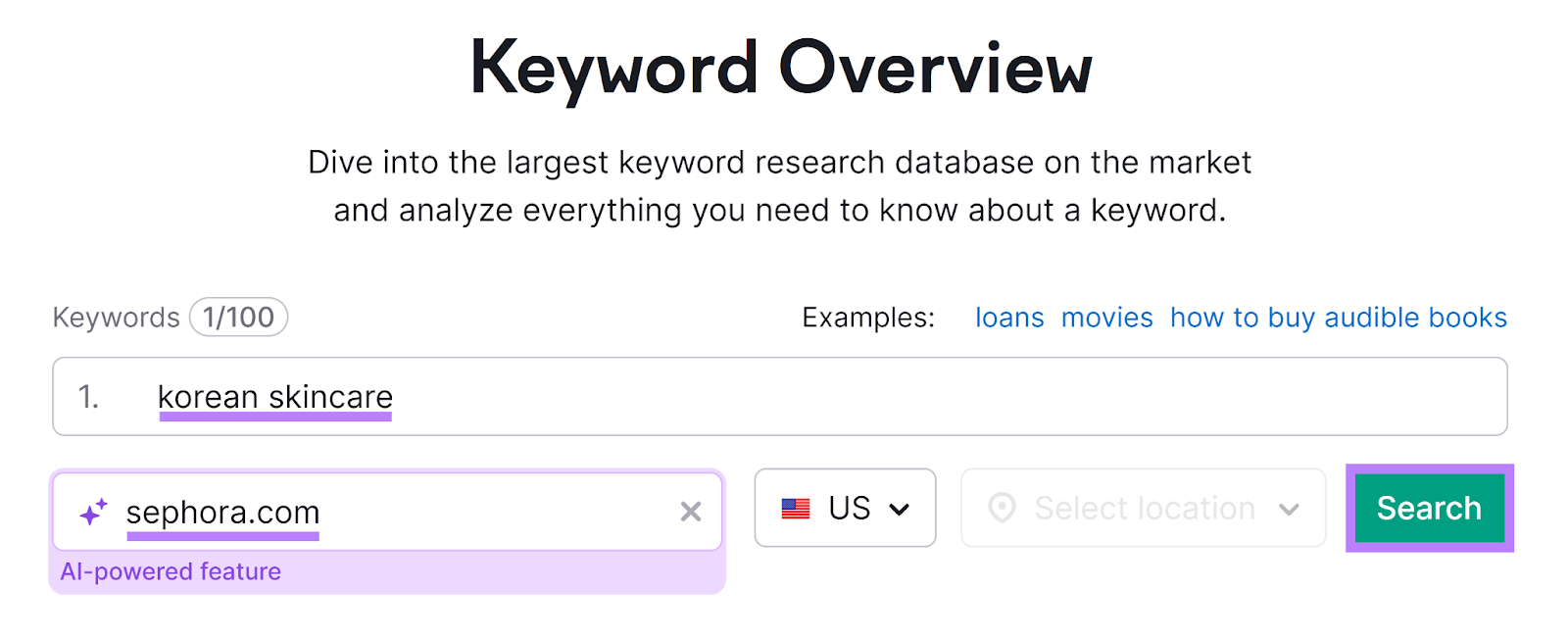
Find the purple “Personal Keyword Difficulty” box. Which contains the following metrics:
- Personal Keyword Difficulty: An AI-powered metric that looks at the difficulty of ranking for a specific keyword for your domain
- Topical Authority: Another AI-powered metric that calculates how authoritative your domain is for the niche or topic group that a keyword belongs to
- Your potential position on SERP: Your estimated position based on your topical authority
- Current position: Where your domain currently ranks for that specific keyword
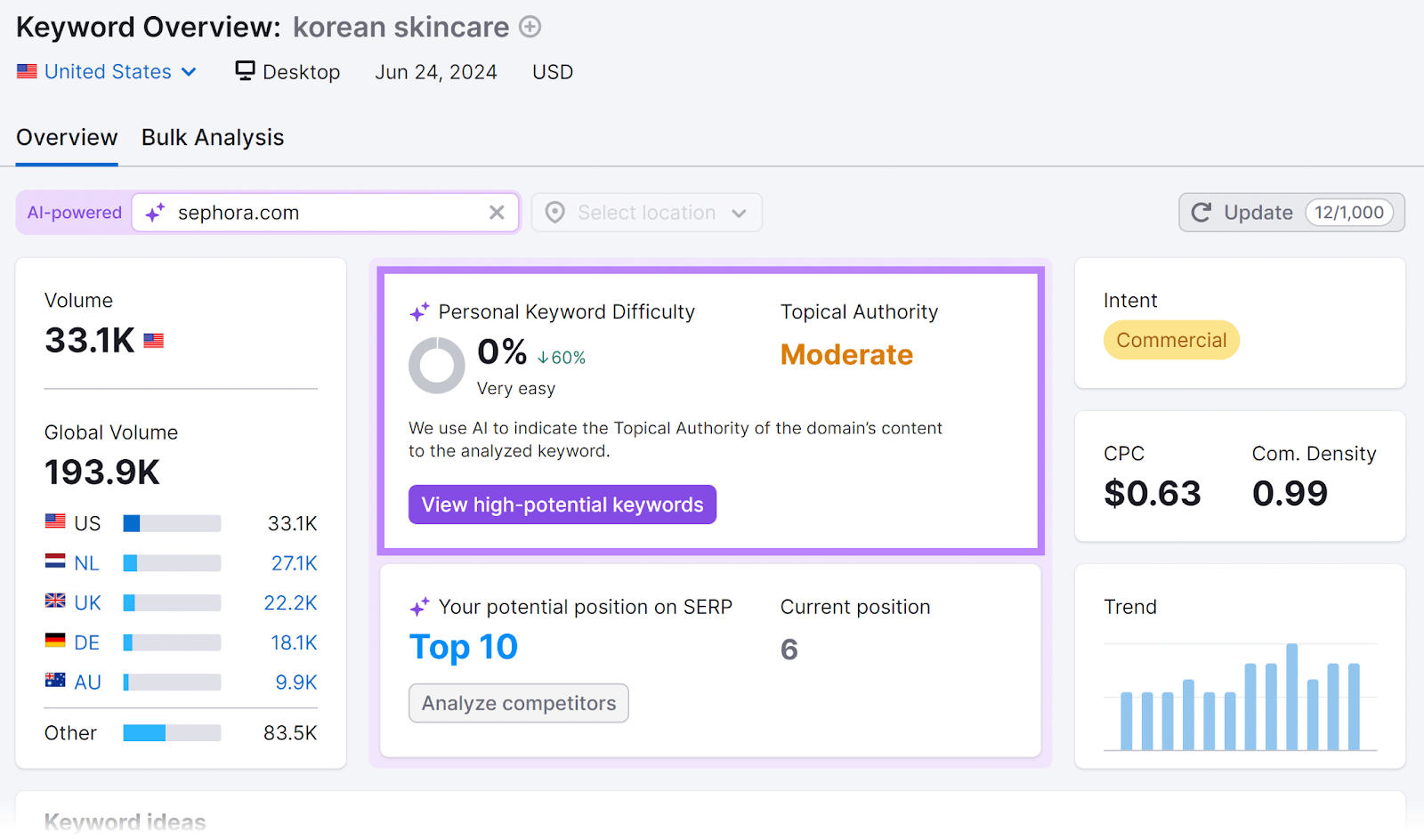
Depending on your website authority, your PKD % might be much lower than the standard one.
For example, Sephora’s PKD % for “korean skincare” is 0%. Compared to the standard score of 60%. Because Sephora’s domain is authoritative regarding skincare topics.
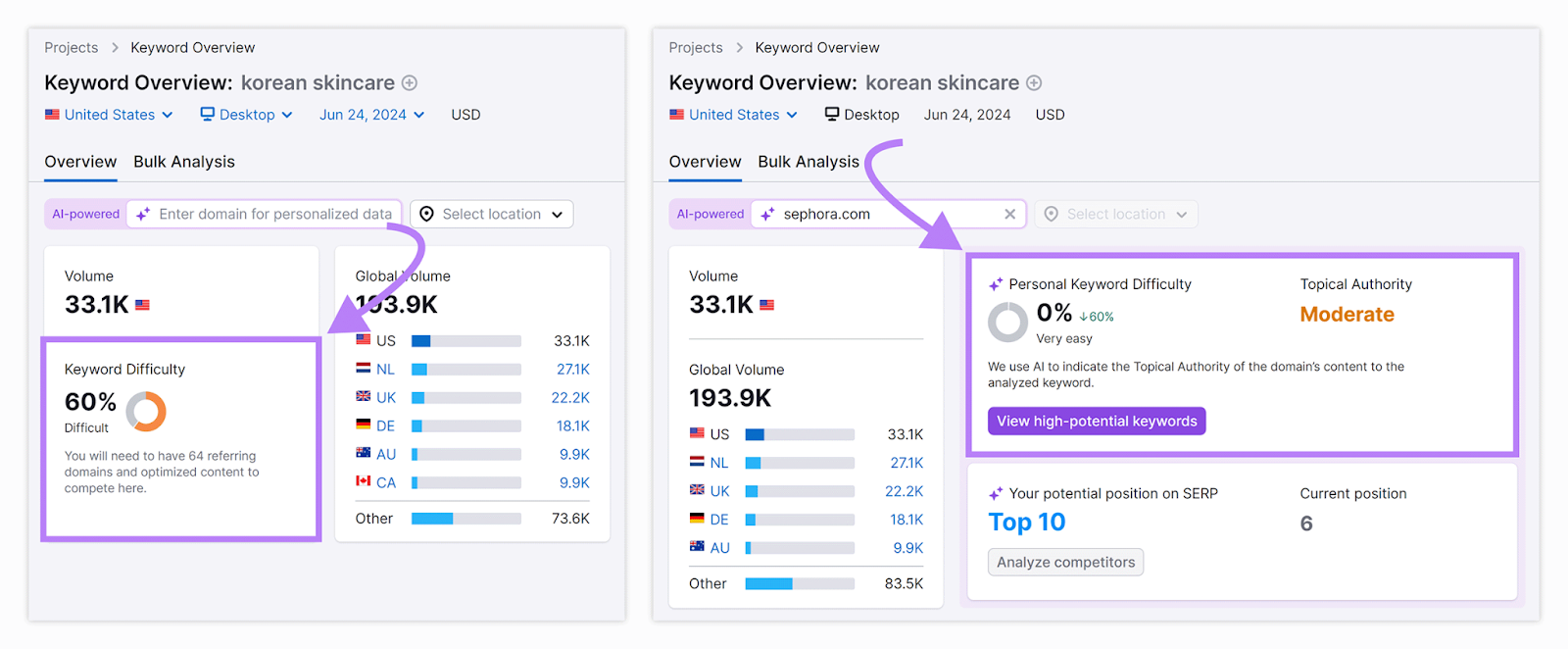
Scroll down to the “Keyword ideas” section to find your PKD % for more related keywords.
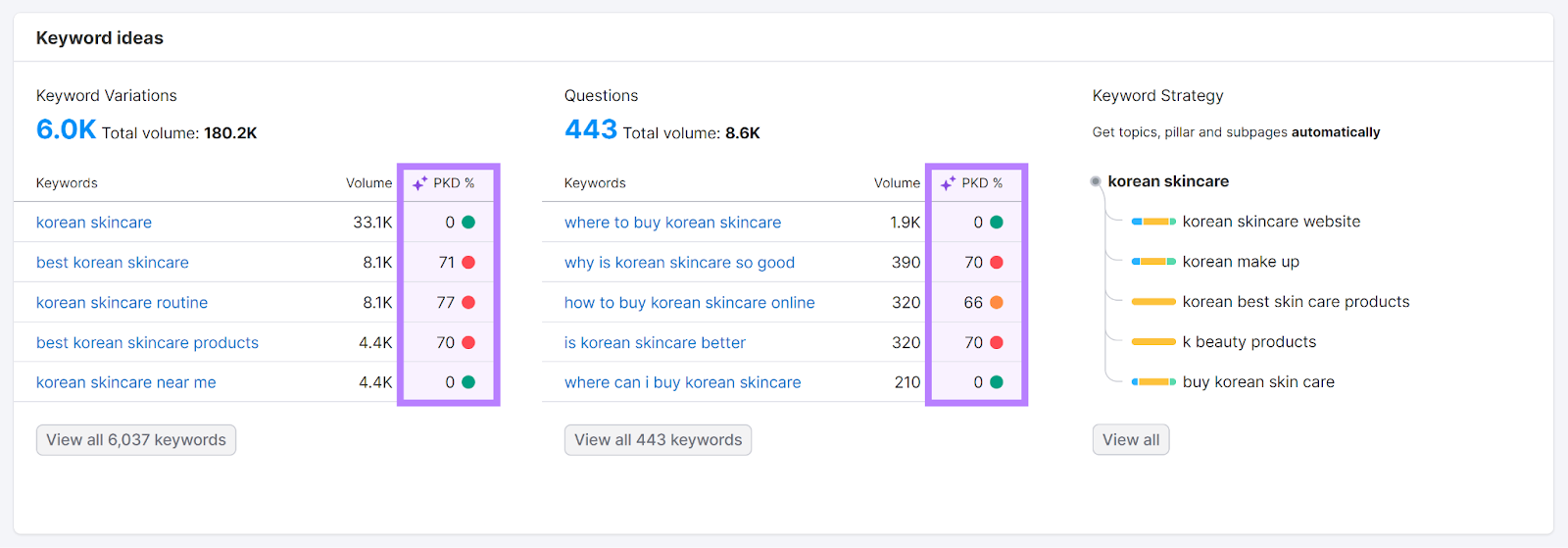
Then, locate the “SERP Analysis” section further down to find your ranking potential. Make sure the “Domain” tab is selected.
In this case, Sephora’s ranking potential is in the “Top 1-10” area.
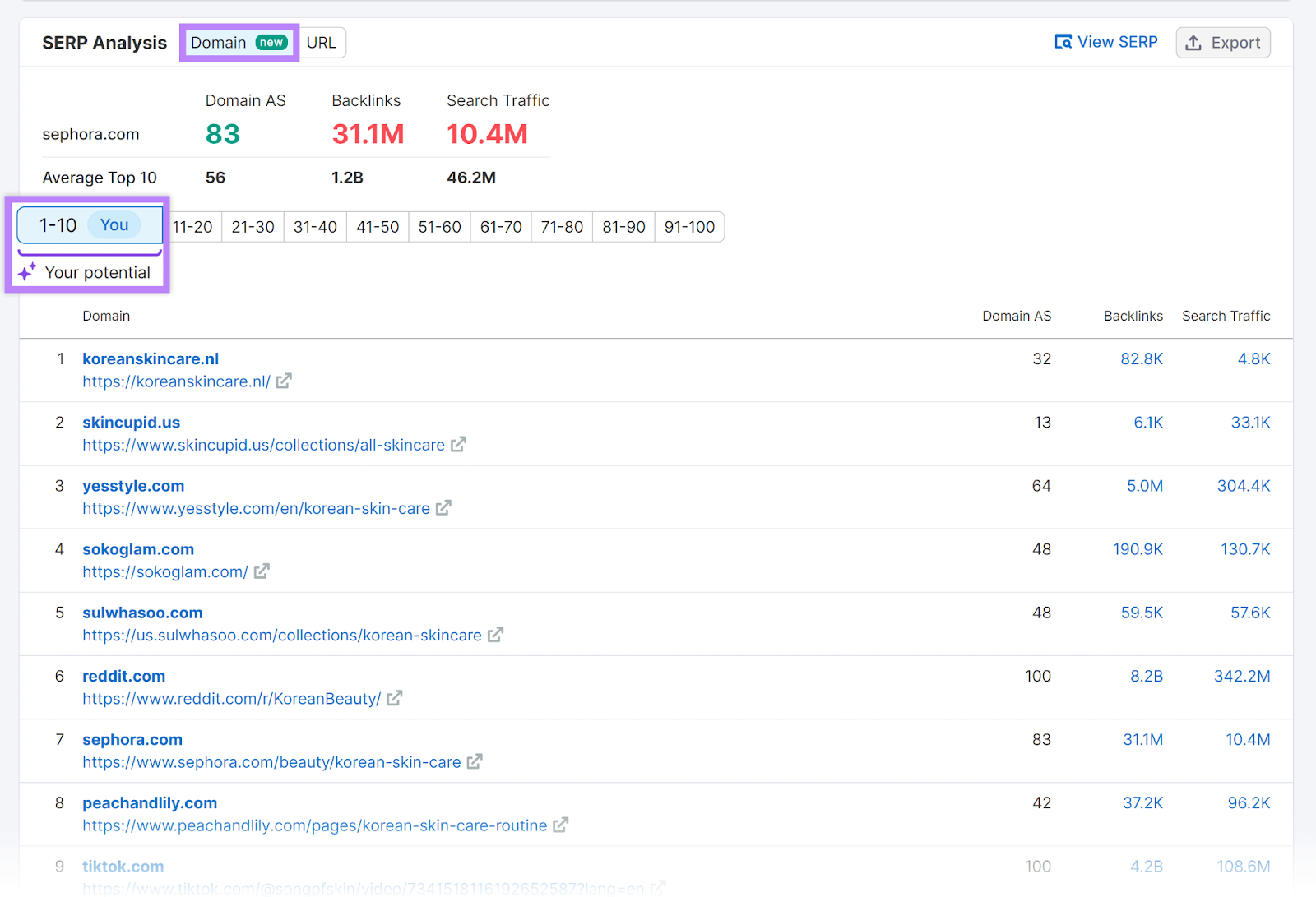
Look for keywords with a PKD % of 0% to 14%. Those are your low-hanging fruit keywords.
Optimize your existing content or create new content around these keywords. To improve your chances for increased visibility in search engines and attract more traffic to your pages.
3. Generate Topic Clusters
With just one seed keyword, AI can generate several topic clusters for your website. Which saves hours on manual keyword research.
A topic cluster is a group of related pages on a website connected via internal links.
It consists of a pillar page and several cluster pages or subpages. The pillar page broadly covers a specific topic. While cluster pages cover subtopics in more detail.
Topic clusters have many advantages, including improving your website’s authority and visibility in search results.
Here’s an example of a topic cluster:
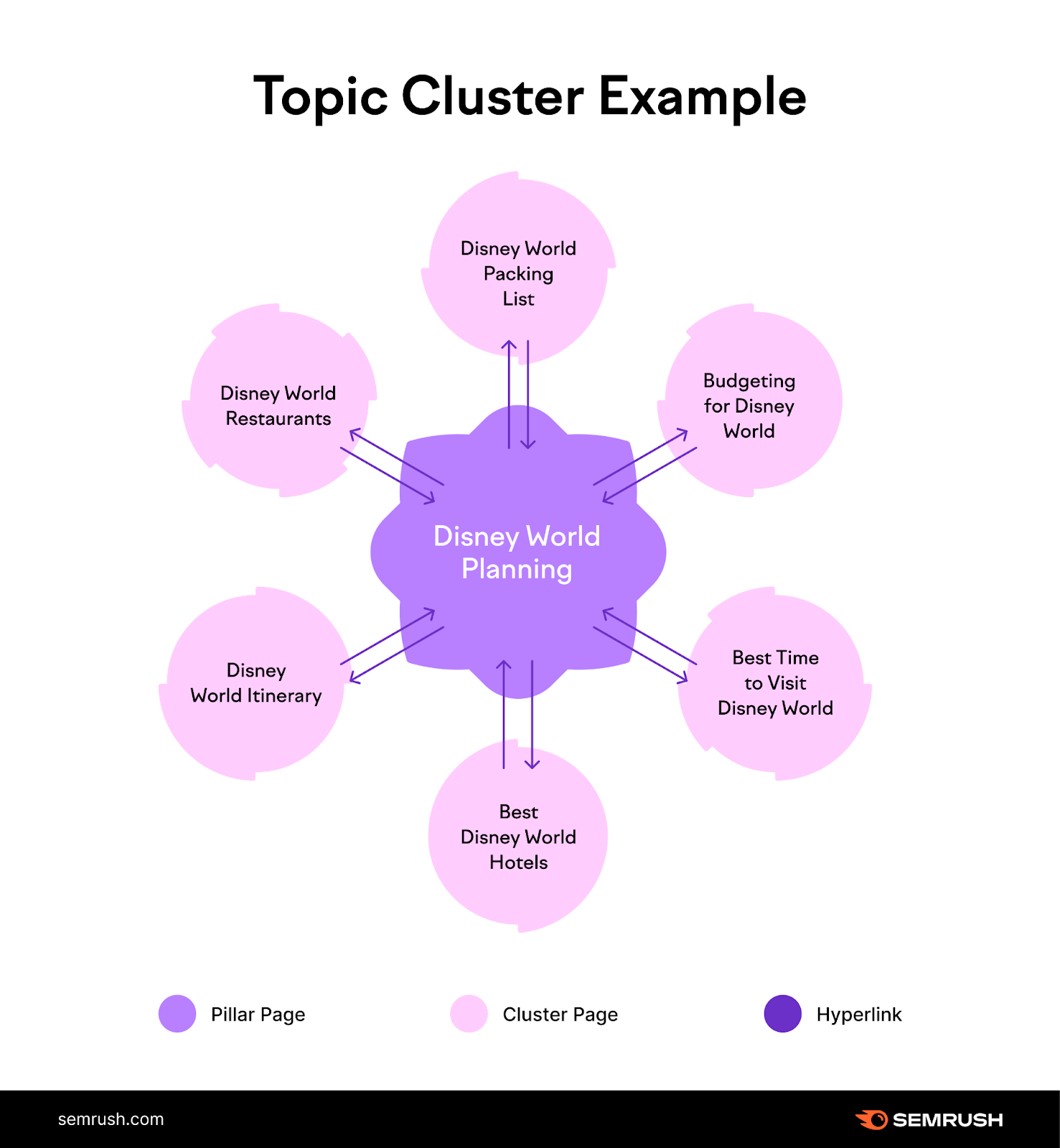
You can find keywords for pillar page and cluster page ideas in a couple of ways.
First, ChatGPT can give you ideas. But again, ChatGPT cannot access proprietary keyword data, so verify its ideas with either Keyword Overview or Keyword Magic Tool.
To use ChatGPT, enter the following prompt in the chat:
PROMPT: My website is about (TOPIC). I want to start a blog to (GOAL).
Generate a list of ideas for a pillar page and associated cluster pages that are relevant, keyword-rich, and can help my website rank better.
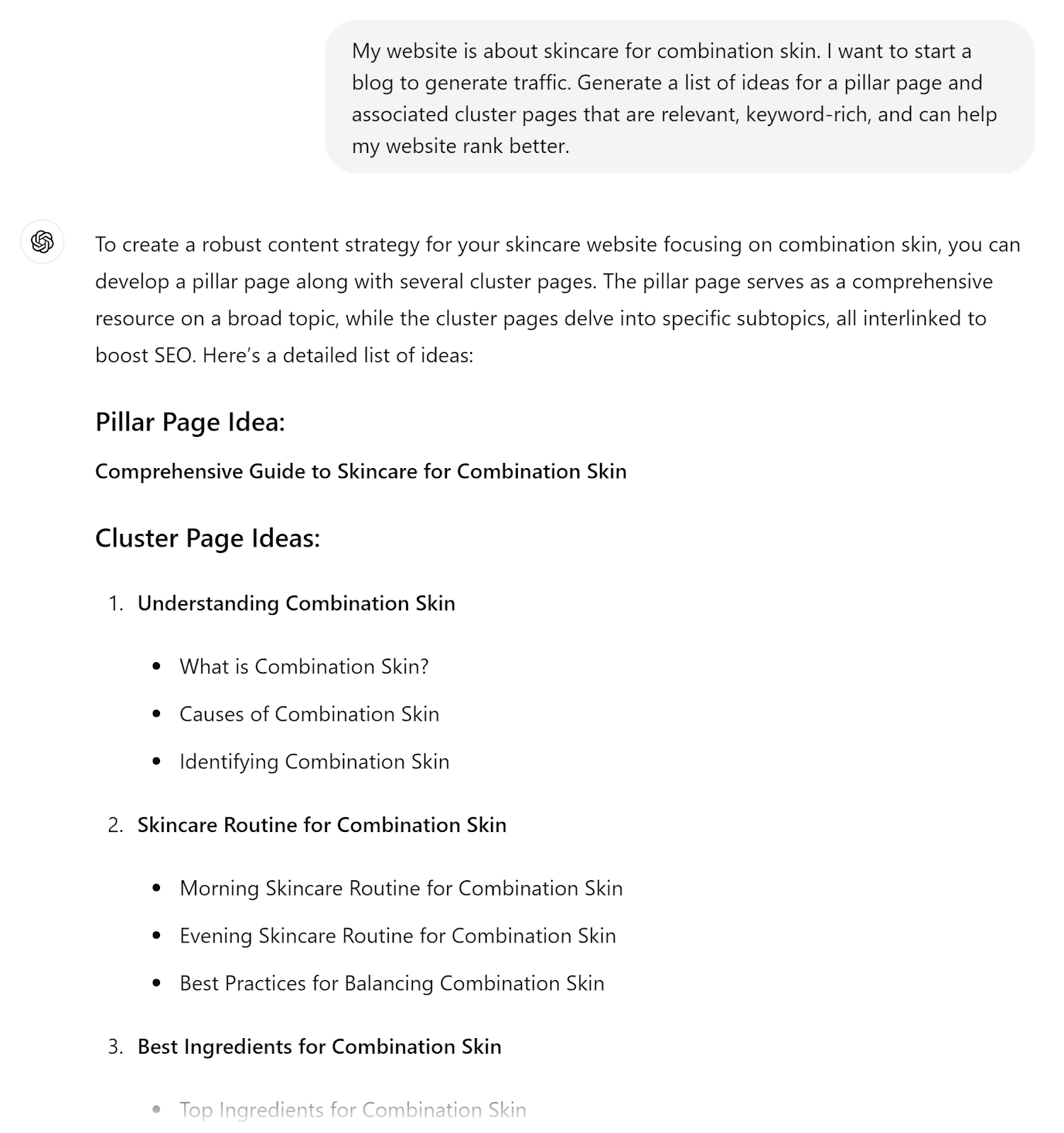
The tool will generate an idea for your main pillar page. And then multiple cluster page ideas.
Second, you can use Semrush’s Keyword Strategy Builder. It uses AI to generate pillar page and cluster page keyword ideas. And gives you up-to-date keyword data with each of its suggestions.
To start, enter a seed keyword. Click “Create list.” Again, we used “combination skin.”
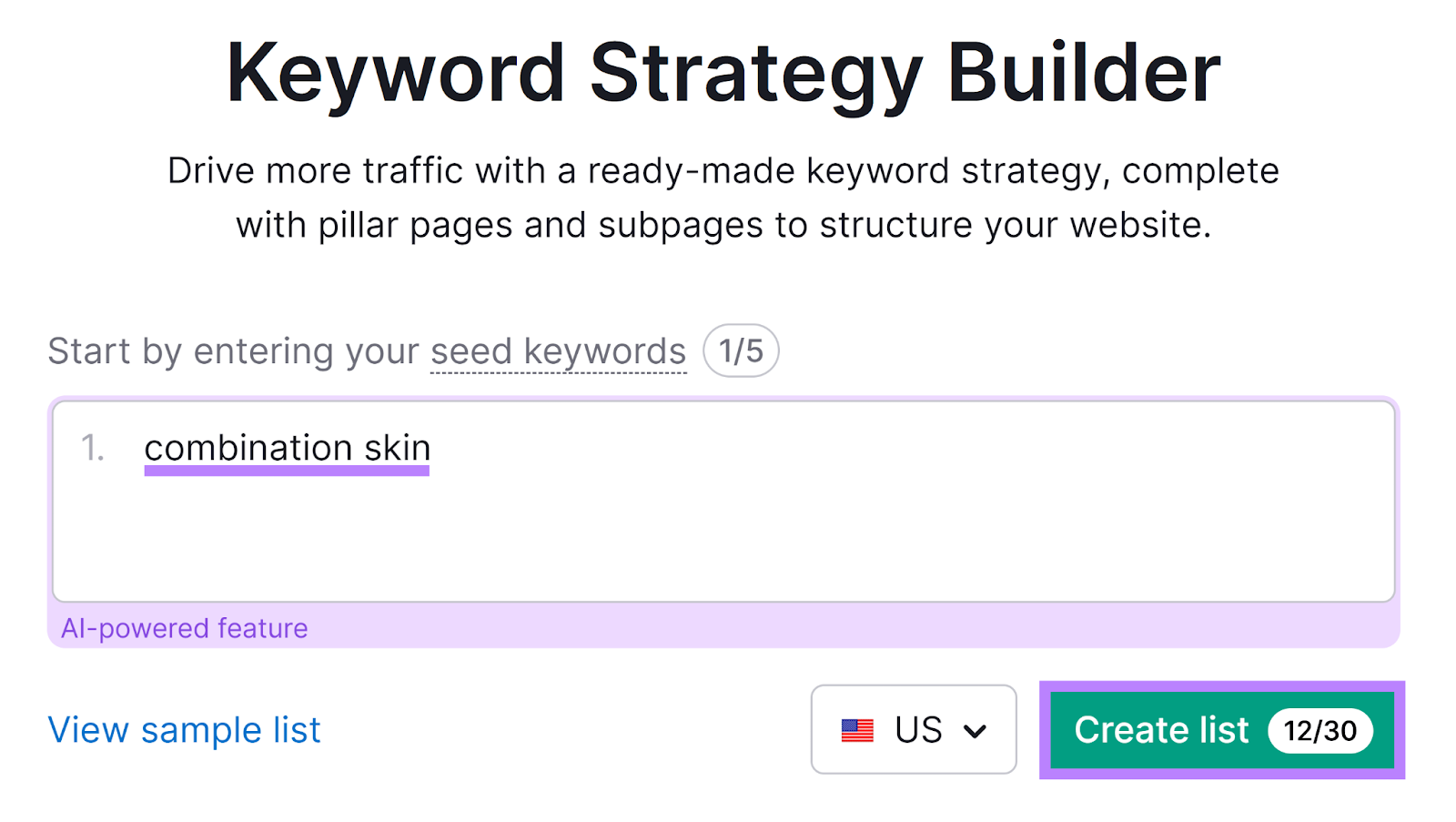
The tool will generate a topical overview graph. With pillar page ideas (e.g., “skincare routine for combination skin”) and subpage ideas (e.g., “best face wash,” “best foundation for oily skin,” “best moisturizer for oily skin.”)
Click on one of the bubbles to get specific keyword data. And the secondary keywords that the pillar or cluster page should also target.
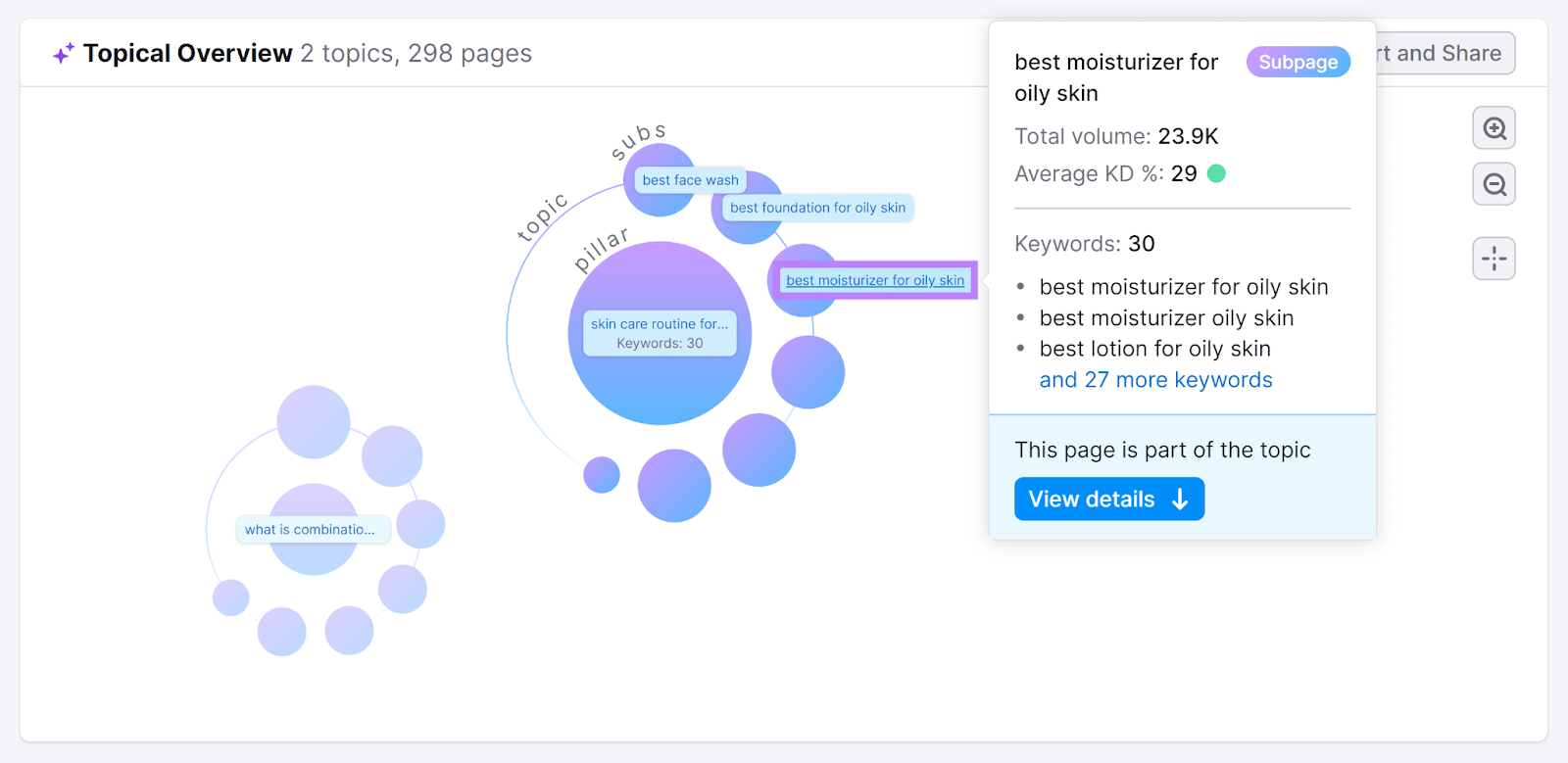
You can also scroll down to see the full list of subpage ideas under each pillar page.
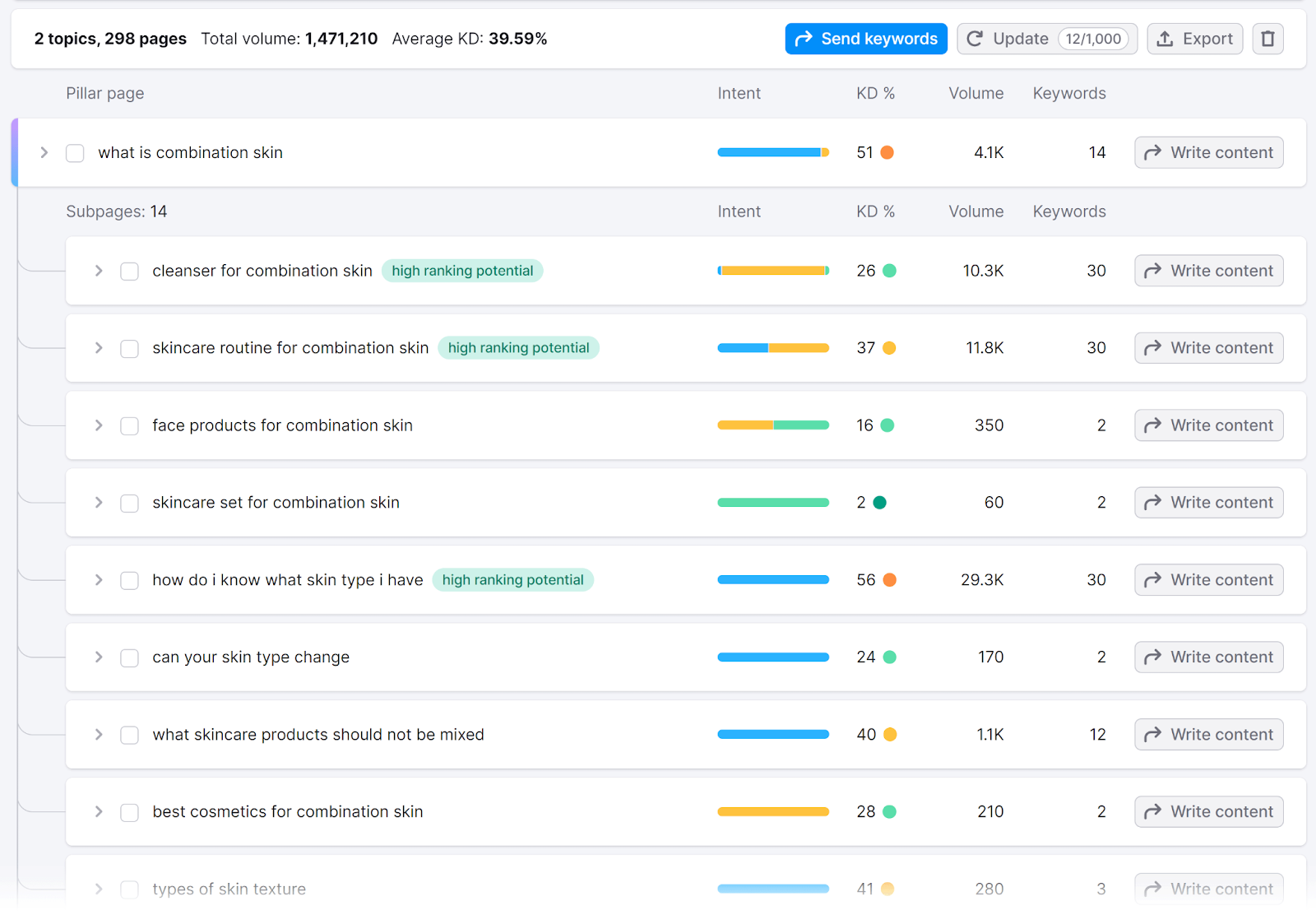
Click on one of the keyword idea rows to see a list of secondary keywords and their keyword data. And the top-ranking pages for that keyword.
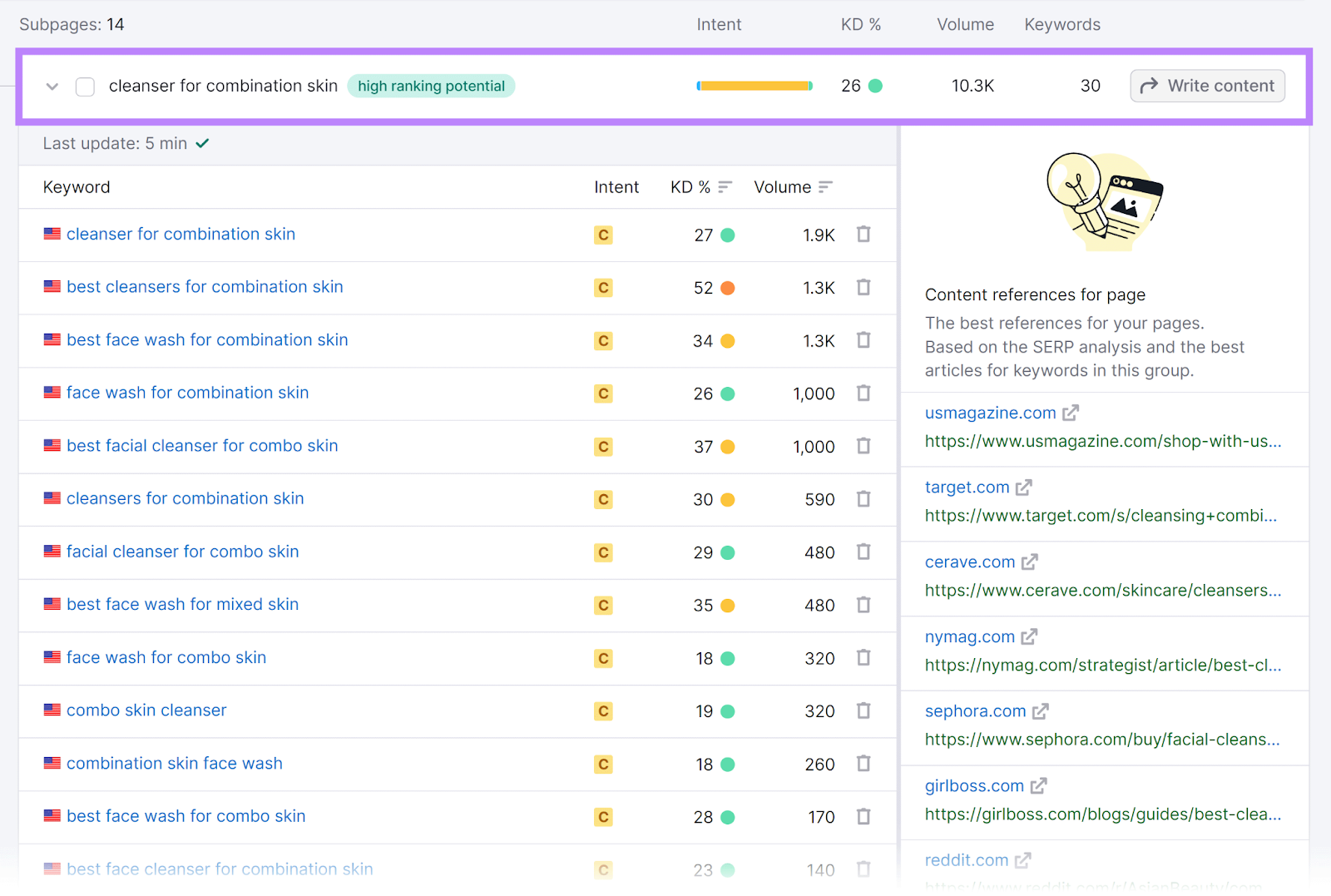
If you want to write about a specific topic, click on “Write content” > “Send keywords” to open the SEO Writing Assistant.
The tool will check your content’s keyword use, readability, originality, and tone of voice as you write. To further increase the chances of your content ranking well.
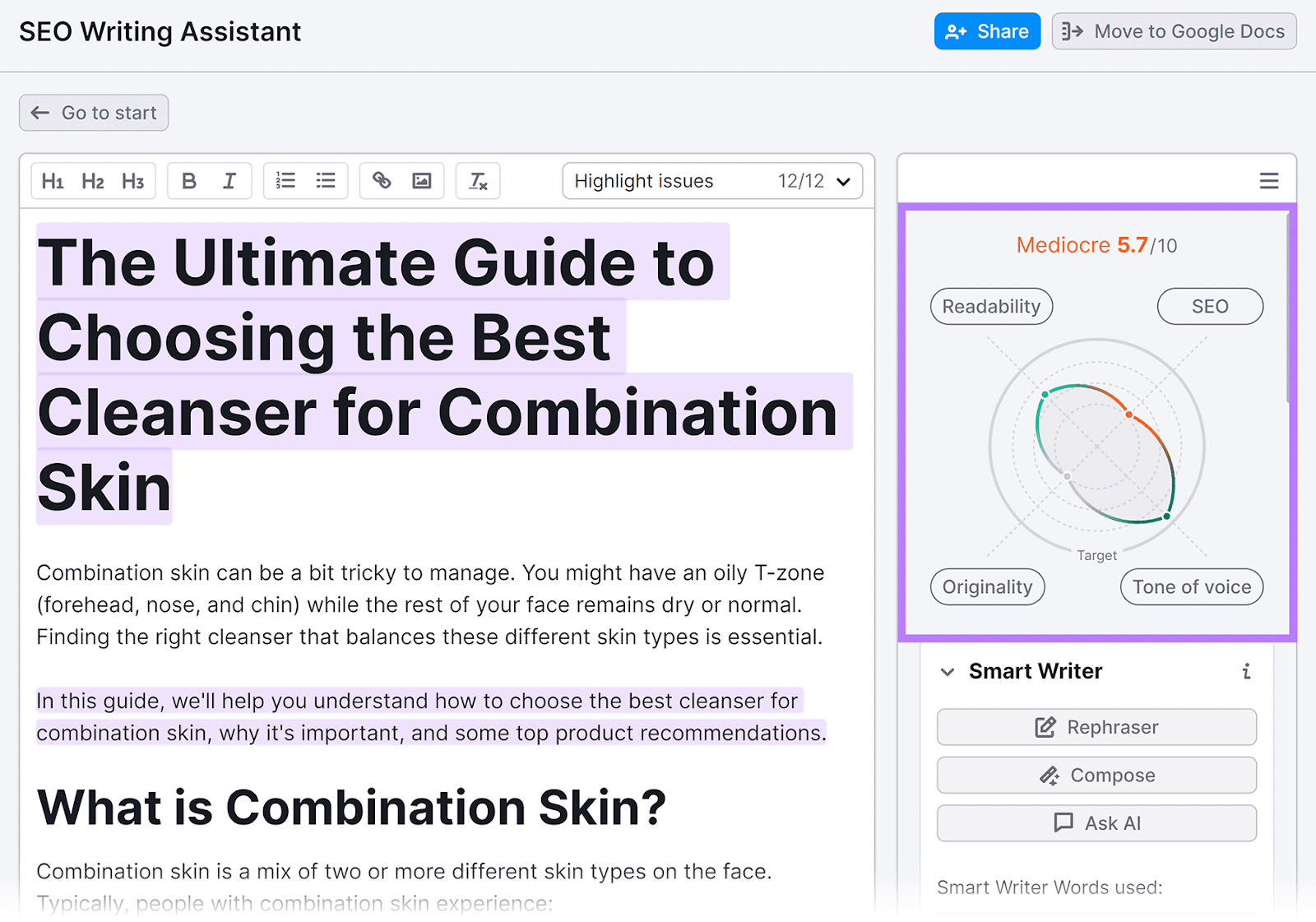
Create content for all the relevant pillar and cluster pages. To establish your authority in your industry and show Google your website is a credible resource.
4. Analyze Search Intent
AI tools for keyword research can determine the search intent of individual keywords. This is helpful when you have a long list of keywords. And want to save time categorizing them into clusters.
Here’s an example using ChatGPT.
PROMPT: Group these keywords based on their search intent (transactional, navigational, commercial, informational).
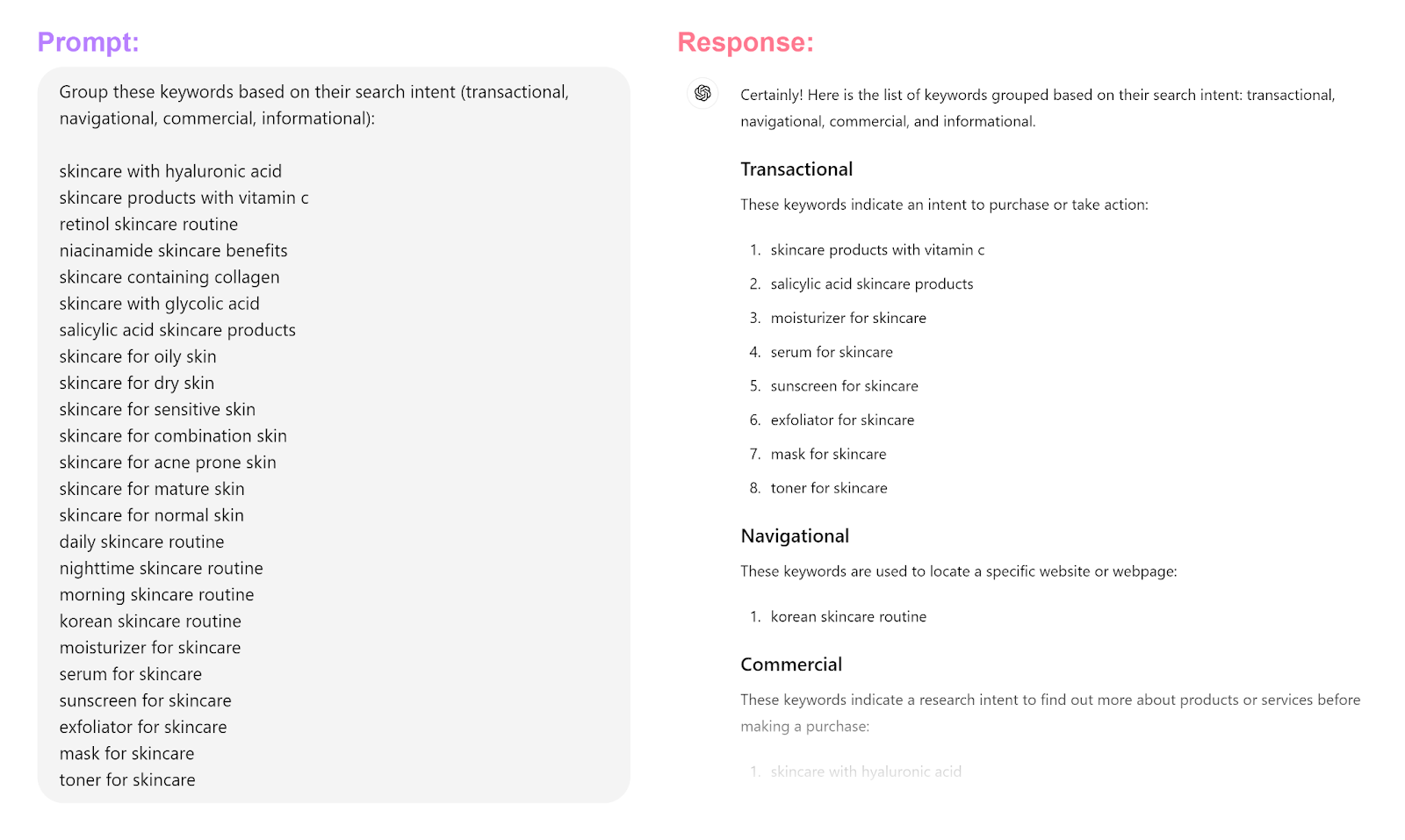
Another way to filter a keyword list is to ask ChatGPT to remove all keywords that don’t have informational or another type of search intent.
However, ChatGPT can make mistakes.
For example, in the screenshot above, it mistakenly identified “Korean skincare routine” as a keyword with navigational intent. But it has informational and commercial intent.
But you can also check the search intent of individual keywords by using Semrush’s Keyword Overview tool.
Type in the keyword and click “Search.” (You can also paste up to 100 keywords for bulk analysis.)
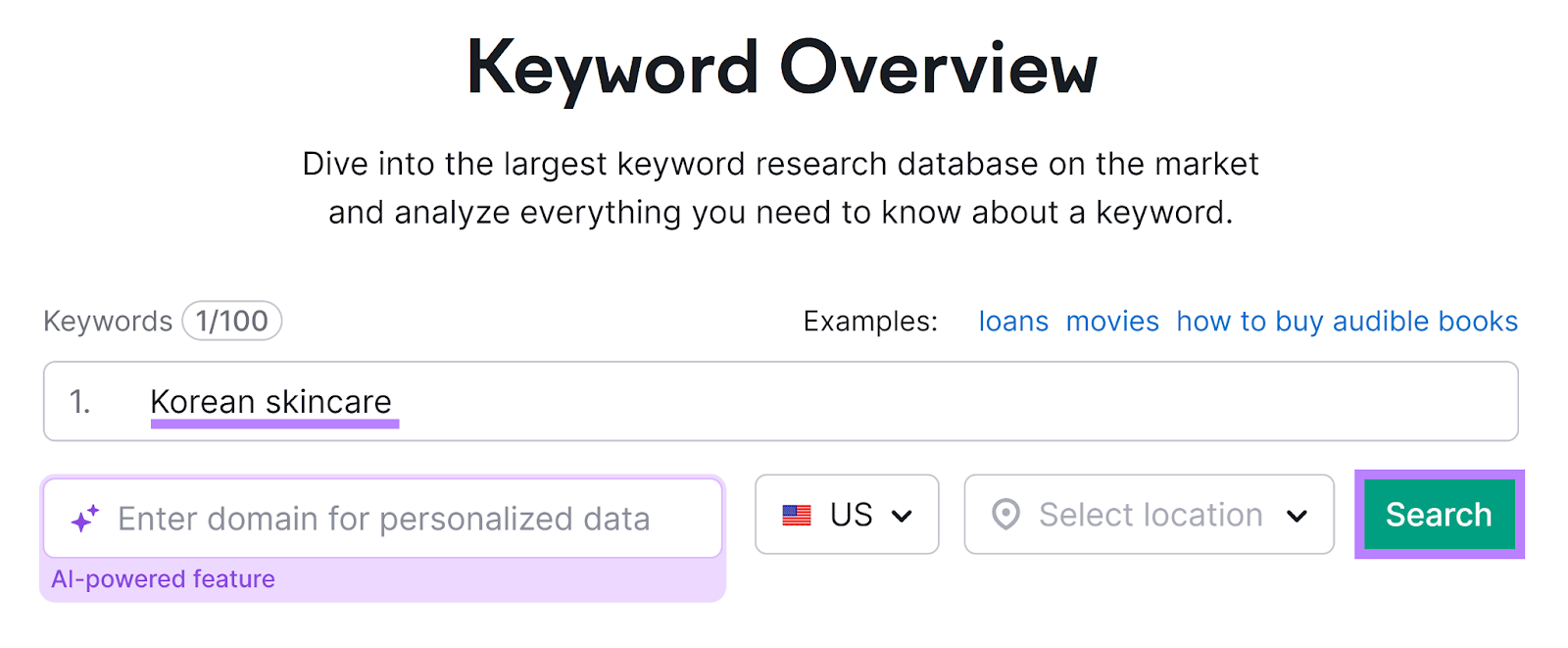
The tool confirms this keyword’s search intent is commercial.
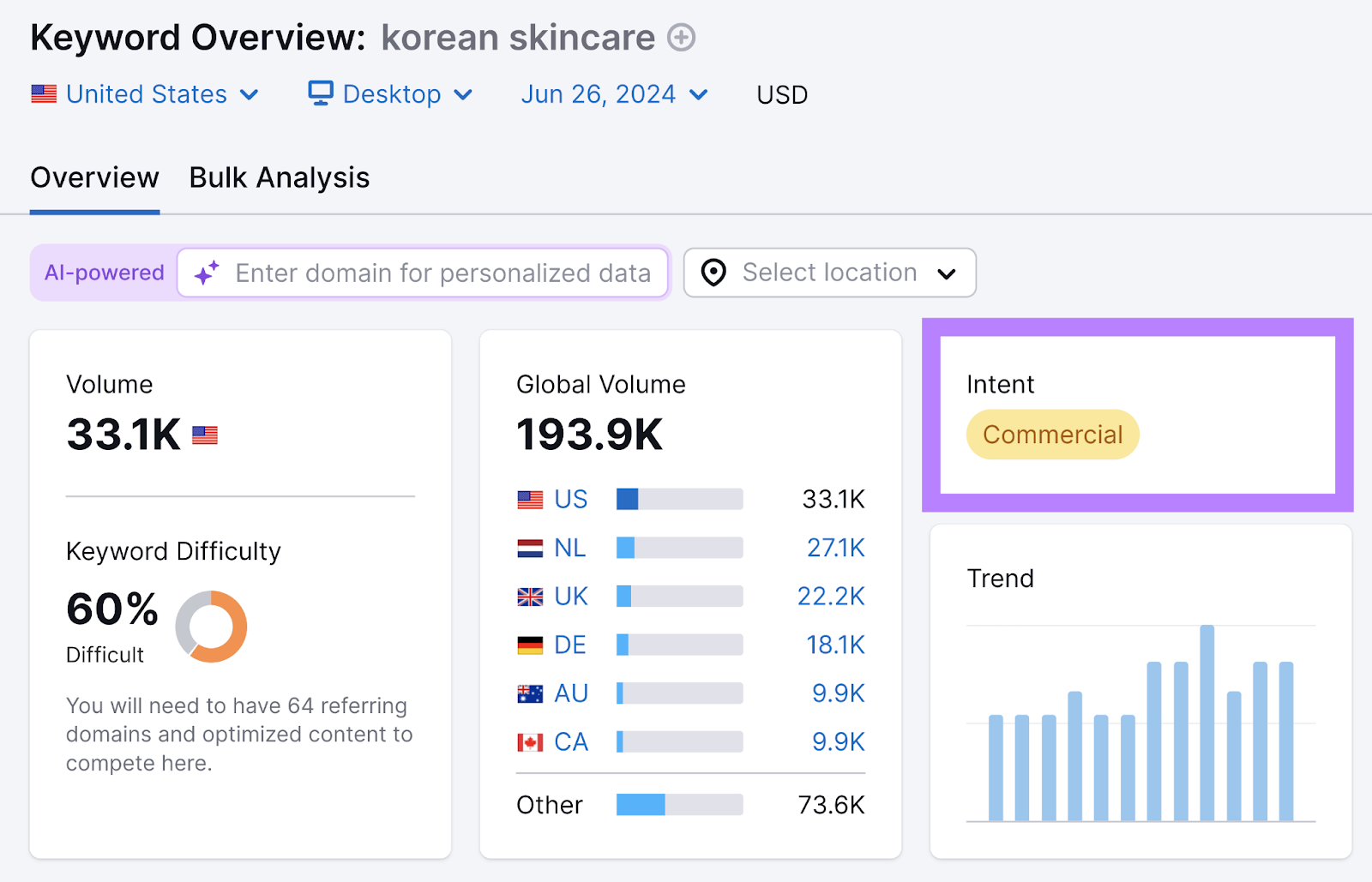
Scroll down to the “SERP Analysis” section to find the top-ranking URLs for your chosen keyword. And open some of the links to double-check the search intent.
For example, most of the top-ranking results for “korean skincare” are online storefronts and product pages. Which further confirms the commercial intent of this keyword.
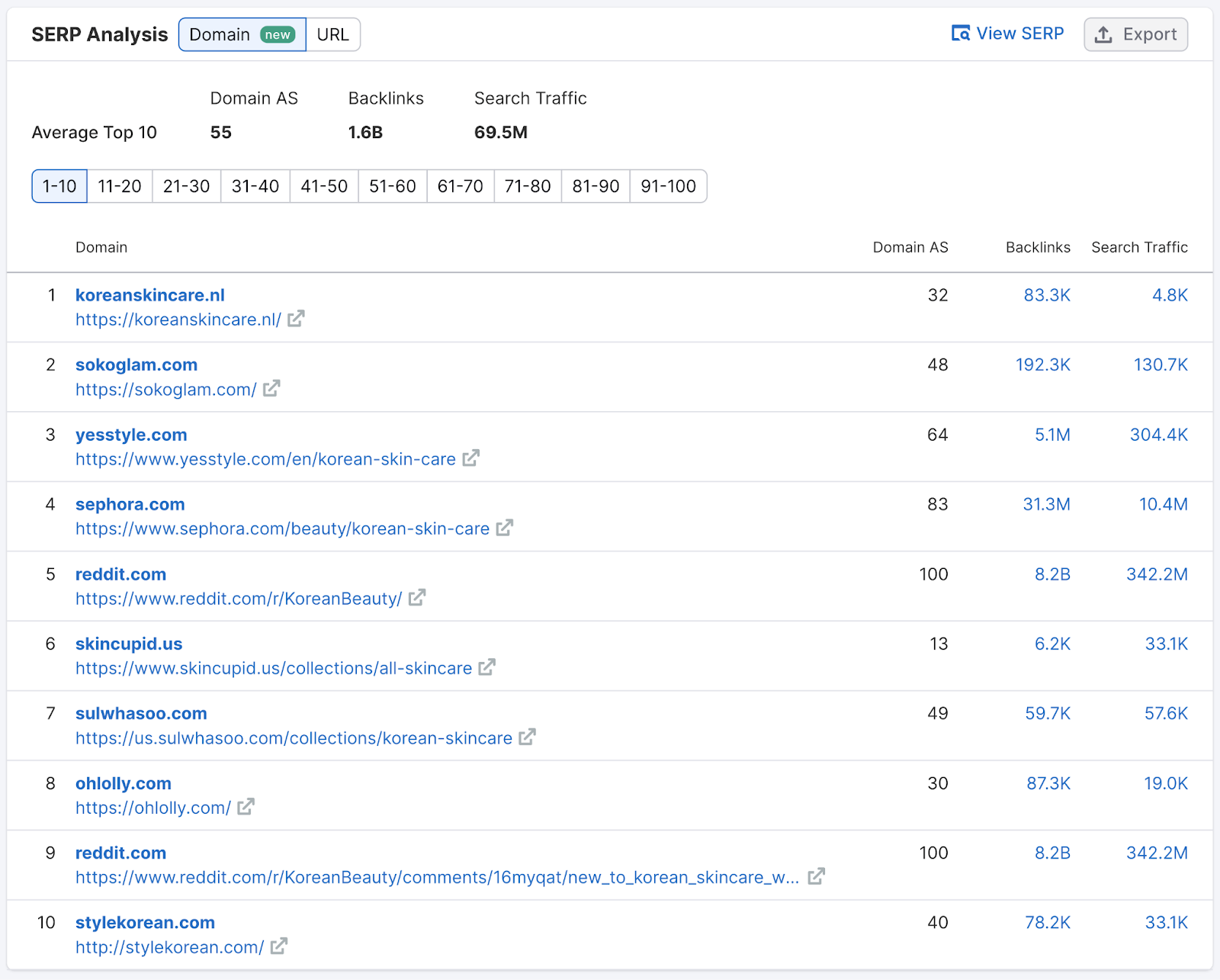
Knowing each keyword’s intent helps you create content that answers your readers’ questions. And this helps your rankings since Google wants to serve searchers results that satisfy their queries.
5. Identify Relevant Secondary Keywords
Secondary keywords complement the target (primary) keyword. They’re usually a synonym of the target keyword or closely related.
Incorporating relevant secondary keywords into a single piece of content can help that piece of content rank for more queries. Which can drive more traffic to your website.
For example, Paula’s Choice’s article on niacinamide generated an estimated 8.2K visits from search engine users over the last month. Because it ranks for 731 keywords, according to Semrush’s Organic Research.
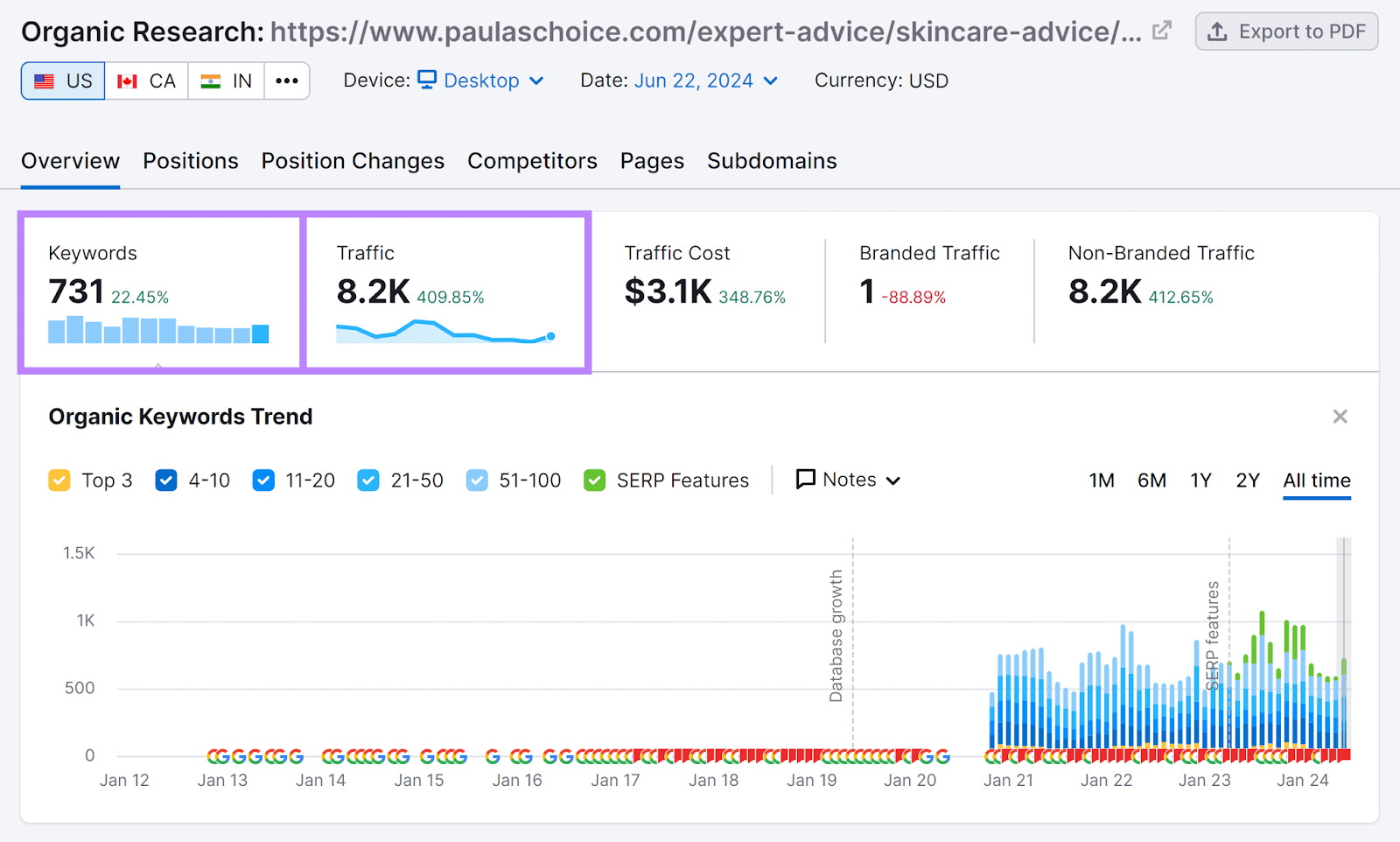
You can find secondary keywords with ChatGPT. That being said, the tool may return keywords that don’t fit the bill.
Use the following prompt for the best results.
PROMPT: Create a list of keywords synonymous with "SEED KEYWORD".
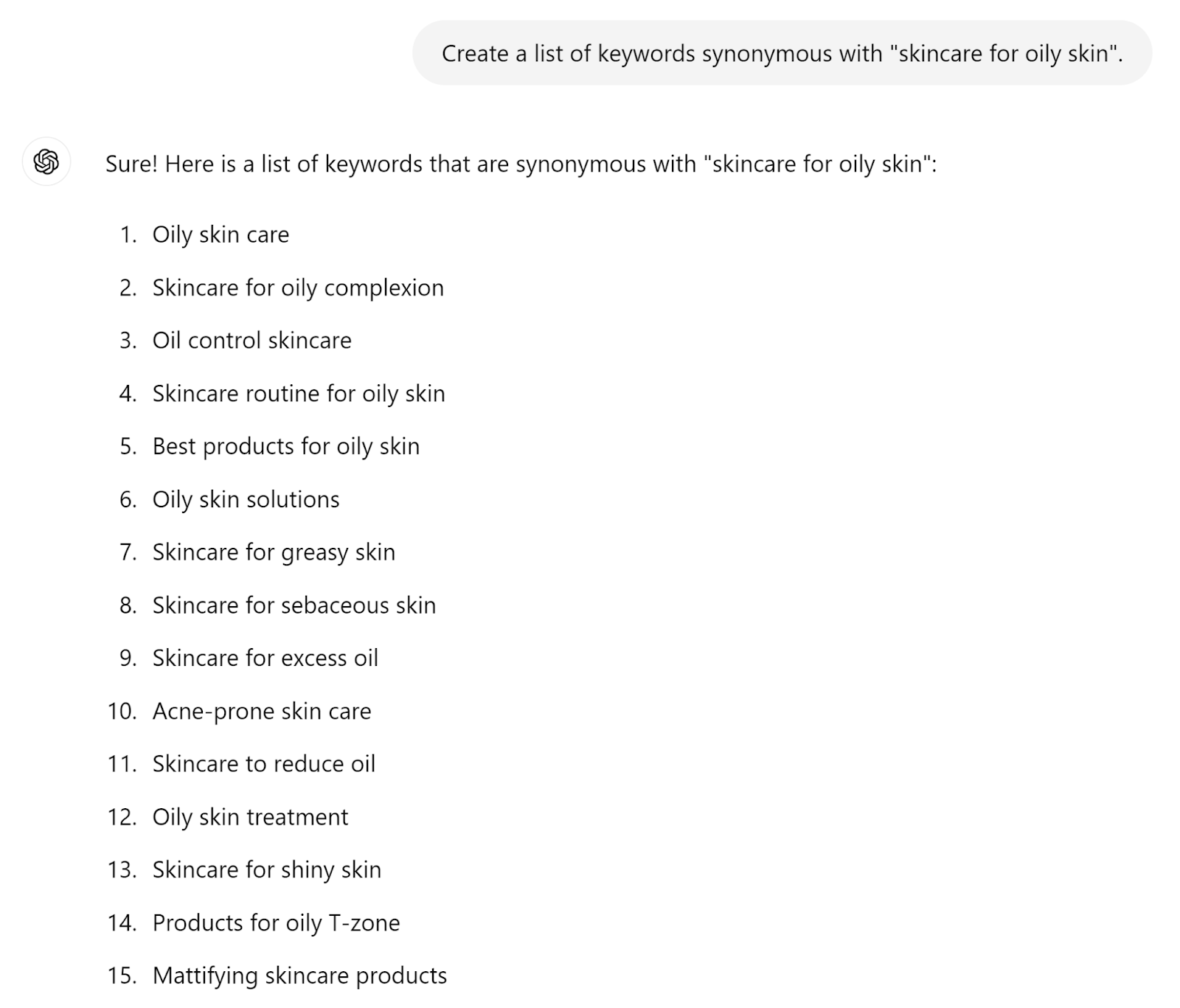
Then, run a Google search to make sure a suggestion is a suitable secondary keyword.
Here’s what the search engine results page (SERP) looks like for our primary keyword “skincare for oily skin” and the suggested secondary keyword “oily skin treatments.”
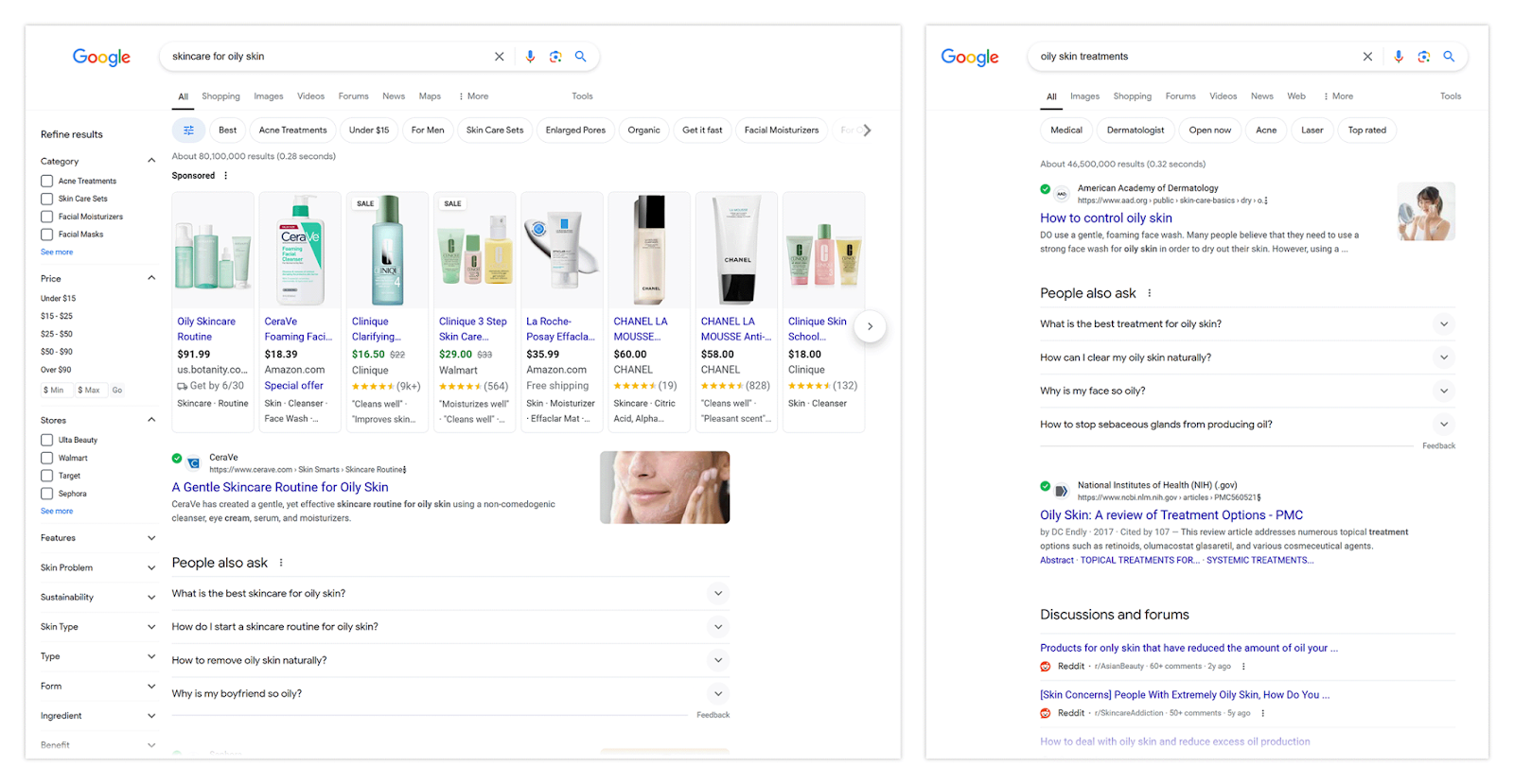
The SERP for the two keywords is completely different. This means ChatGPT’s suggestion “oily skin treatments” isn’t a good secondary keyword.
However, “regimens for oily skin” has more SERP overlap with our primary keyword. Which makes it a suitable secondary keyword to include in our content.
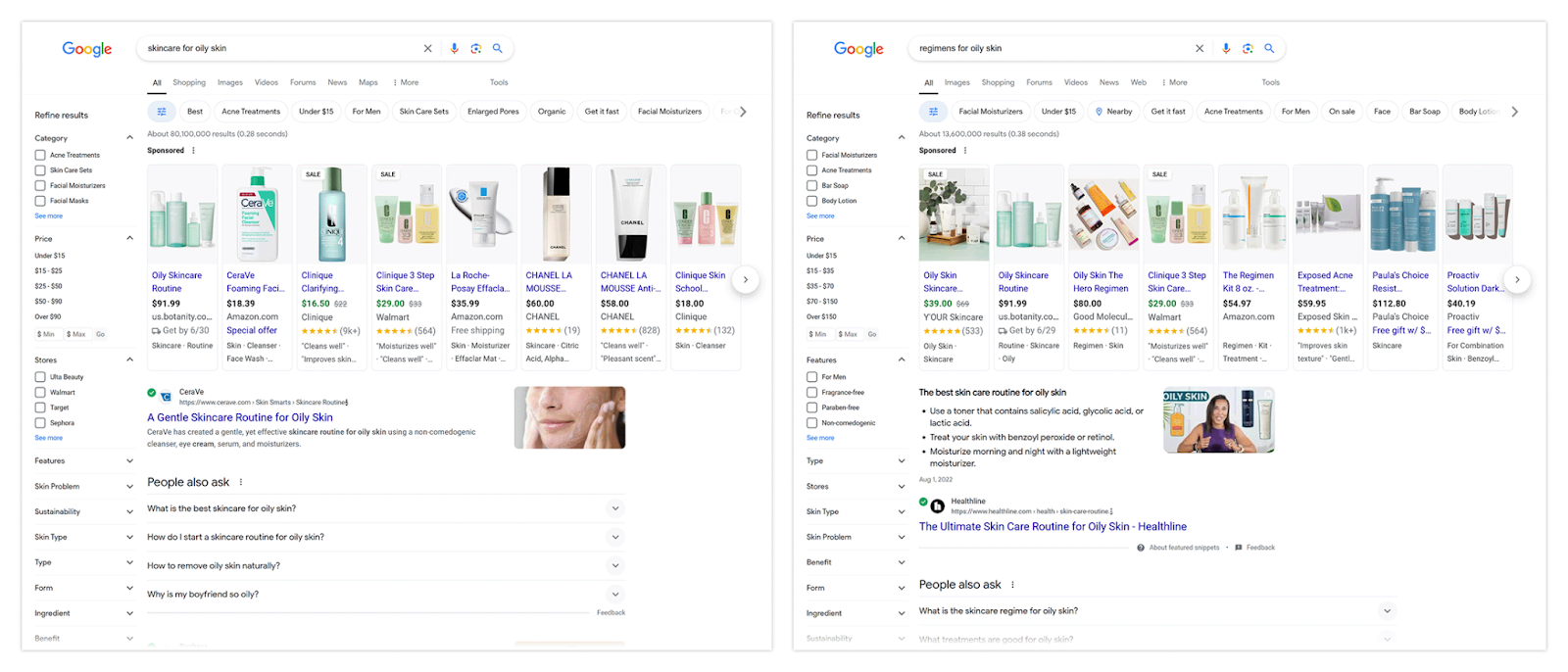
Another way to find secondary keywords is with Semrush’s Keyword Strategy Builder. It automatically groups all related keywords into a single cluster. This saves time on manually comparing SERPs.
Enter a seed keyword into the tool. And wait for the ideas to generate.
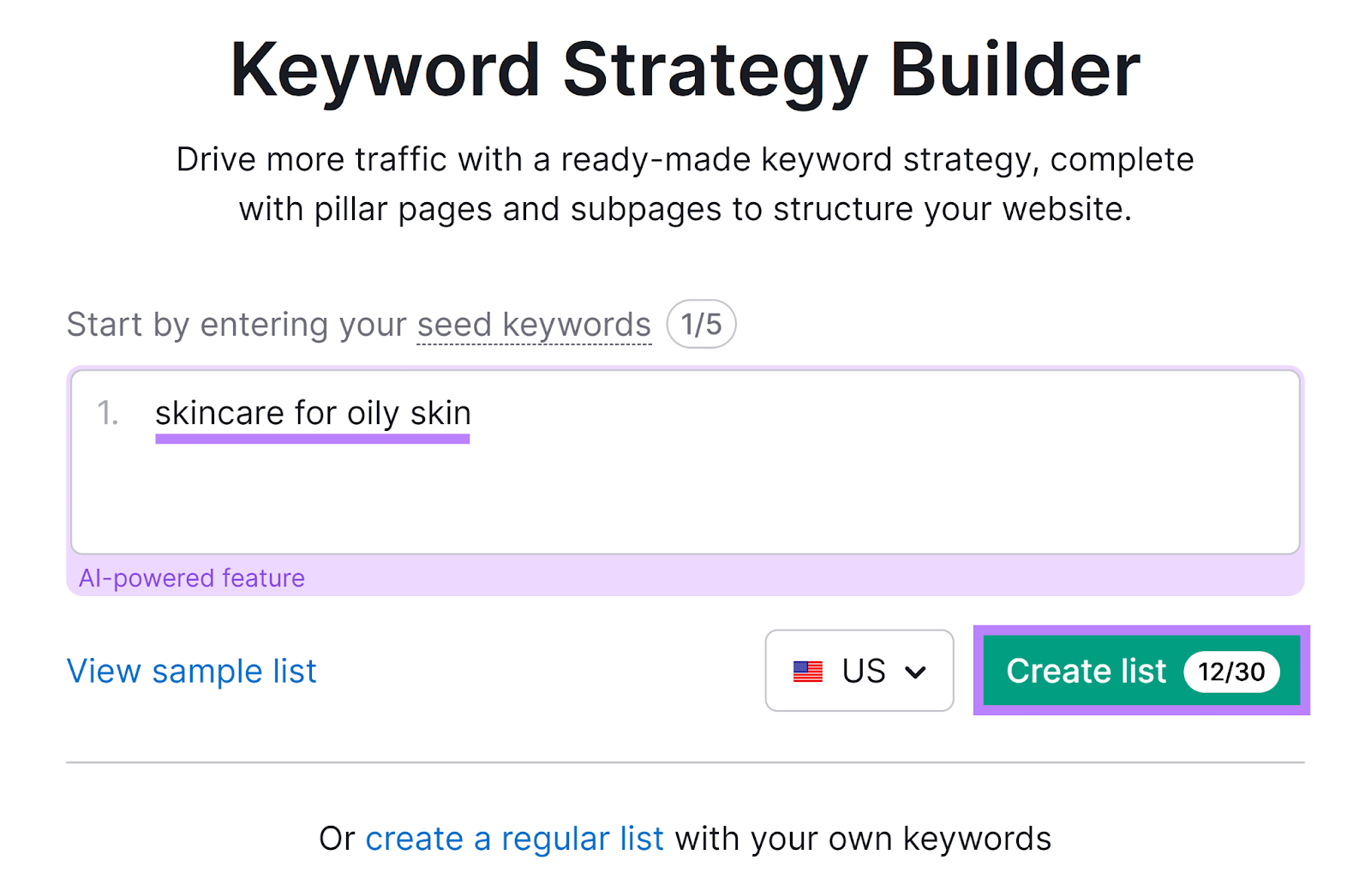
To find secondary keywords, click on a pillar page or subpage. A secondary keyword list will appear below.
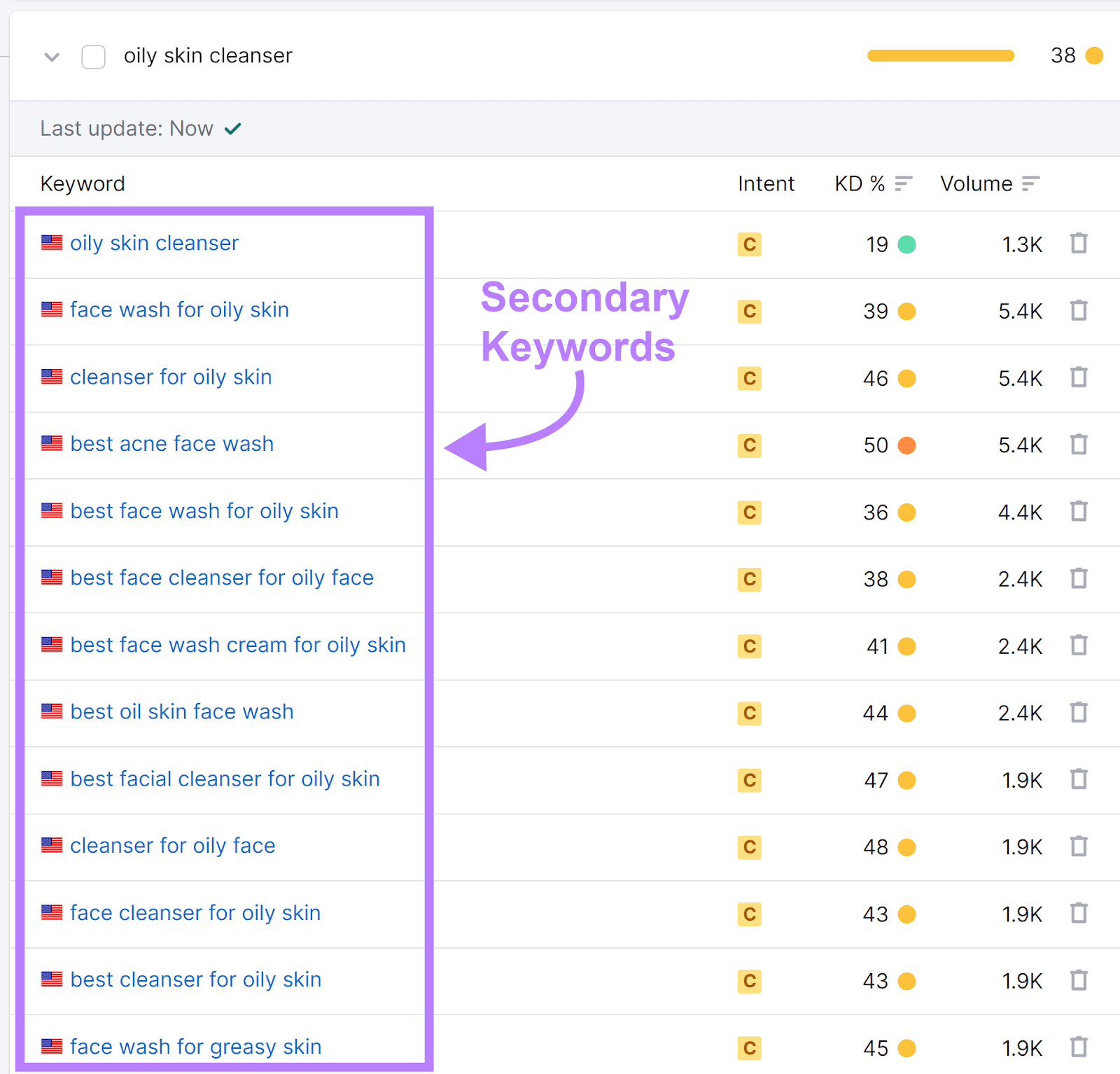
Optimize your content with both primary and secondary keywords. To generate more traffic from single pieces of content.
Streamline Your SEO with the Right AI Keyword Research Tools
Now that you know how to use AI for keyword research, it’s time to boost your results with Semrush.
Our AI-powered tools provide the in-depth insights you need for a winning SEO strategy. From analyzing your competitors to finding the perfect keywords for your audience.
Get started with a free account. And join companies like Flowrite that increased their monthly organic traffic to 1 million with our toolkit.
